Solid Starts Guide to High Chairs for Babies

A properly positioned high chair can increase the length of time a child is willing to sit for a meal. More importantly, studies show that proper positioning reduces the risk of choking. This page explains what our licensed feeding therapists look for in a high chair and shares our recommendations and reviews of popular high chairs.
Solid Starts is an independent organization that does not accept money or free products in exchange for reviews. Any recommendations here are our opinions and are free from conflict of interest. Even though there are hundreds of high chair options on the market, there is no perfect chair that is also affordable.
How to Choose a High Chair
When considering a high chair, our licensed professionals look for the following:
Completely upright seat
Adjustable, large footrest
Ideal position for trunk, pelvis & lower body
Minimal potential for falls
Minimal potential for caregiver tripping
Removable tray (so chair can be used at table)
Ability to transition with the child’s growth and eating ability
Length of use, maximum weight, maximum age, and durability
Recommended High Chairs for Babies
Below are some high chairs that meet our standards in 2024. Few chairs made the cut, and the ones that did are pricey. See our list of online retailers that sell used or “gently loved” high chairs or ask your local consignment shop. Alternatively, check out the pros and cons of our favorite budget-friendly high chairs. No matter which high chair is available, you can always modify a high chair to better support baby.
Solid Starts is independent, and we recommend a product only when we believe that it is worth your consideration. We provide affiliate links to retailers of those products, and we may receive a commission if you purchase through one of those links. Learn more.

Top 2 Recommended High Chairs
The following chairs best met our criteria: They are safe for all methods of starting solids. They have ideal positioning with minimal tipping and tripping hazards. They feature a five-point safety harness so a child cannot climb out of the chair. They can be used well into childhood, which means you won’t need to buy a second chair as baby grows.
Remember: A child’s feet may not touch the ground from an adult chair until 8 or 9 years of age. If you want a child to sit still for meals, you’ll want a chair that can grow with the child or have some form of foot support until their feet touch the floor.
Mockingbird High Chair


This chair supports baby from infancy through early childhood. It has excellent positioning for safety and an easy-to-adjust footrest. It also has a smaller footprint than many high chairs on the market. Lastly, the chair (and straps!) are exceptionally easy to clean.
UPPAbaby Ciro High Chair


This chair is easy to clean (even the straps can be removed and washed) and it has a sleek design with good positioning to keep baby safe at mealtime. Downsides: it has a large, wide footprint, it lacks an infant bucket seat, and it does not convert into a toddler chair.
→ Read Our UPPAbaby Ciro High Chair Review

Runners-Up
The following chairs met most of our criteria, but each has minor flaws.
Abiie Beyond
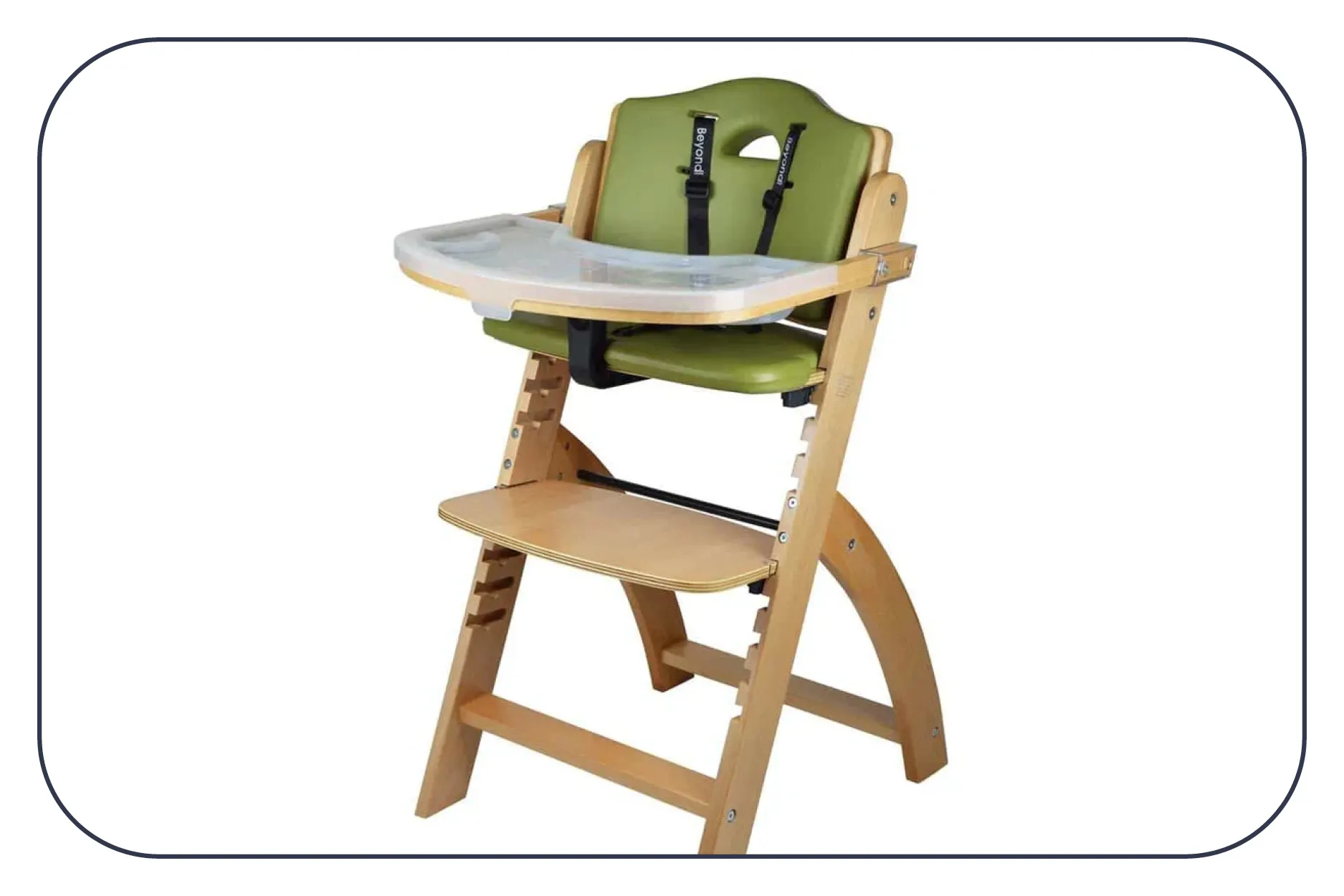


This chair is a decent, slightly more affordable alternative to the Stokke Tripp Trapp and offers good positioning with its upright seat and adjustable footrest. Downsides: it lacks an infant bucket seat, which limits use of the chair at the table without the tray until a child is quite steady on their own.
→ Read Our Abiie Beyond Review
Ergo Baby Evolve



This well-designed chair is a great option for those who want to fold up the chair when it is not in use. Offers good positioning, with an adjustable footplate; it is easy to clean; and it easily converts into a toddler chair. Downsides: it lacks an infant bucket seat, which limits the use of the chair at the table without the tray until a child is quite steady on their own. The footprint is also a bit big and wide, which may lead to caregiver tripping.
→ Read Our Ergo Baby Evolve Review
Lalo



This chair offers good positioning and the removable tray and machine-washable cushion are easy to clean. Because the footplate is not adjustable, the chair may not suit smaller babies as well, but it transitions well into a toddler chair.
Nomi
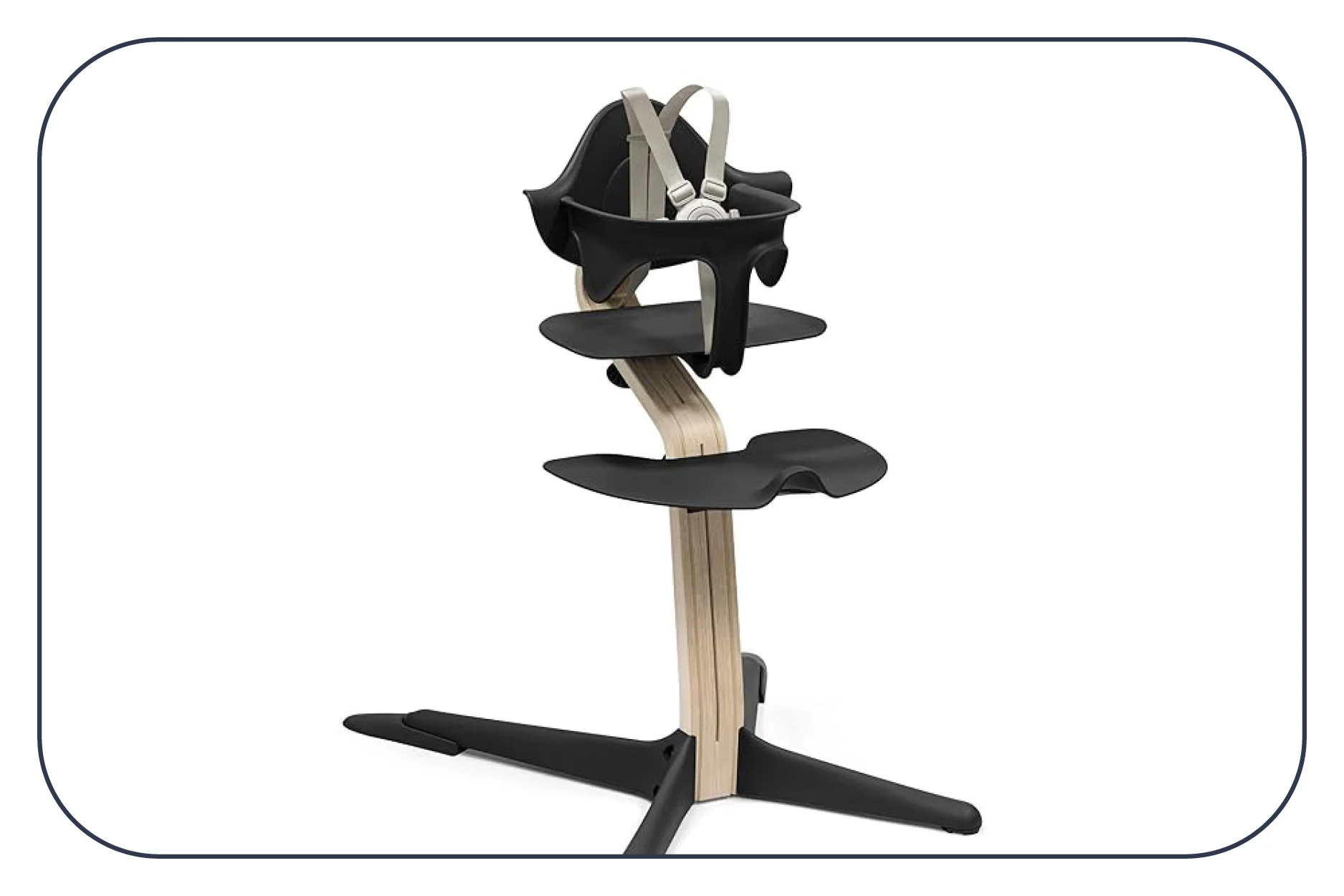


While it offers excellent positioning for babies, toddlers, and older children alike, and it is one of the easiest to clean chairs, Nomi is not without its flaws. Smaller babies may not feel as supported and larger children may find the seat base to be too small. The chair also needs regular tightening of screws at the base to be stable.
Stokke Tripp Trapp
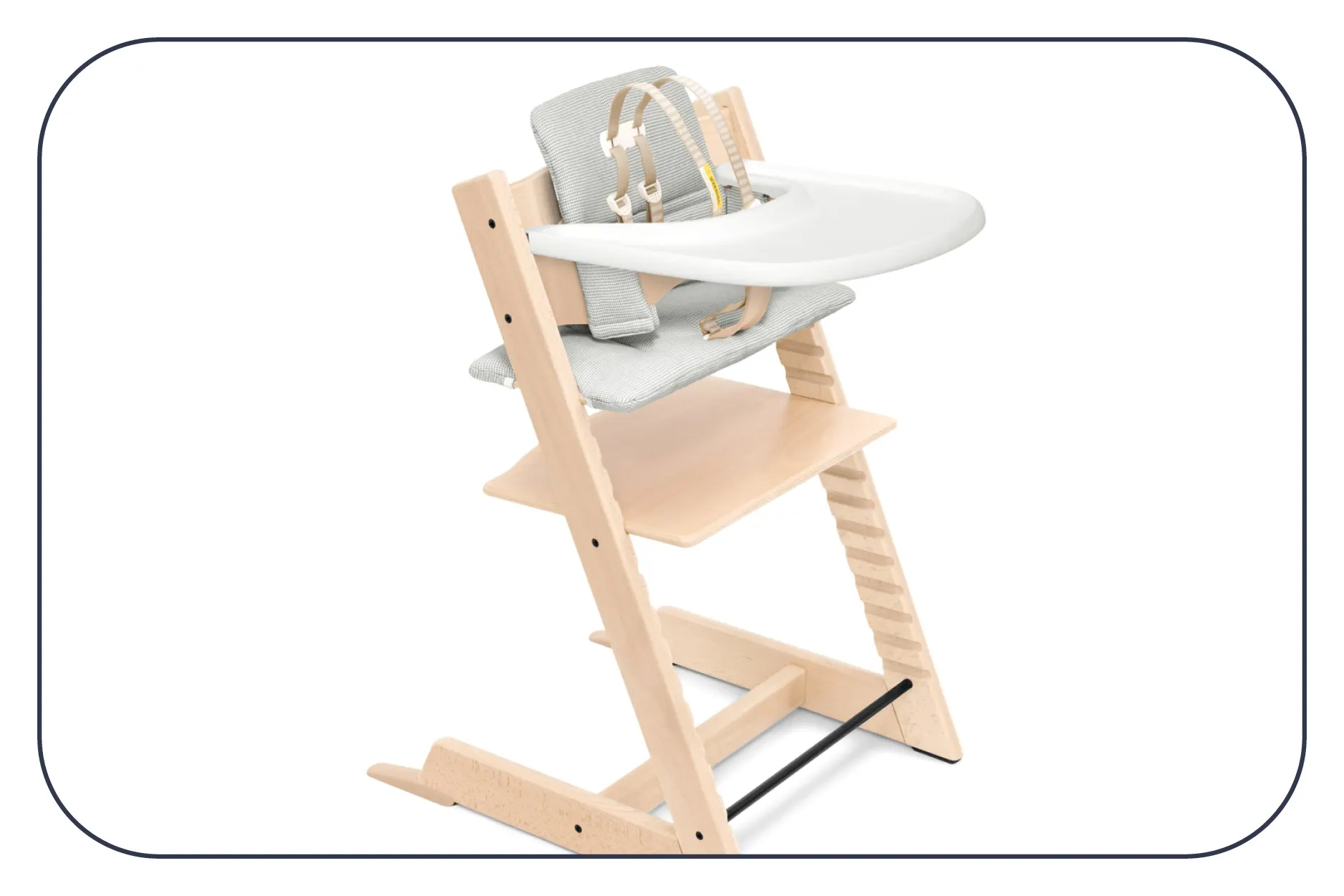


The chair that revolutionized high chairs. Offers excellent positioning for babies, toddlers, and children of all ages, though the flat, wood seat is not as comfortable as high chairs with more contour. Downsides: product assembly is time consuming, and the straps and grooves in the wood are hard to clean.
→ Read Our Stokke Tripp Trapp Review
Best Budget-Friendly Chairs for Babies
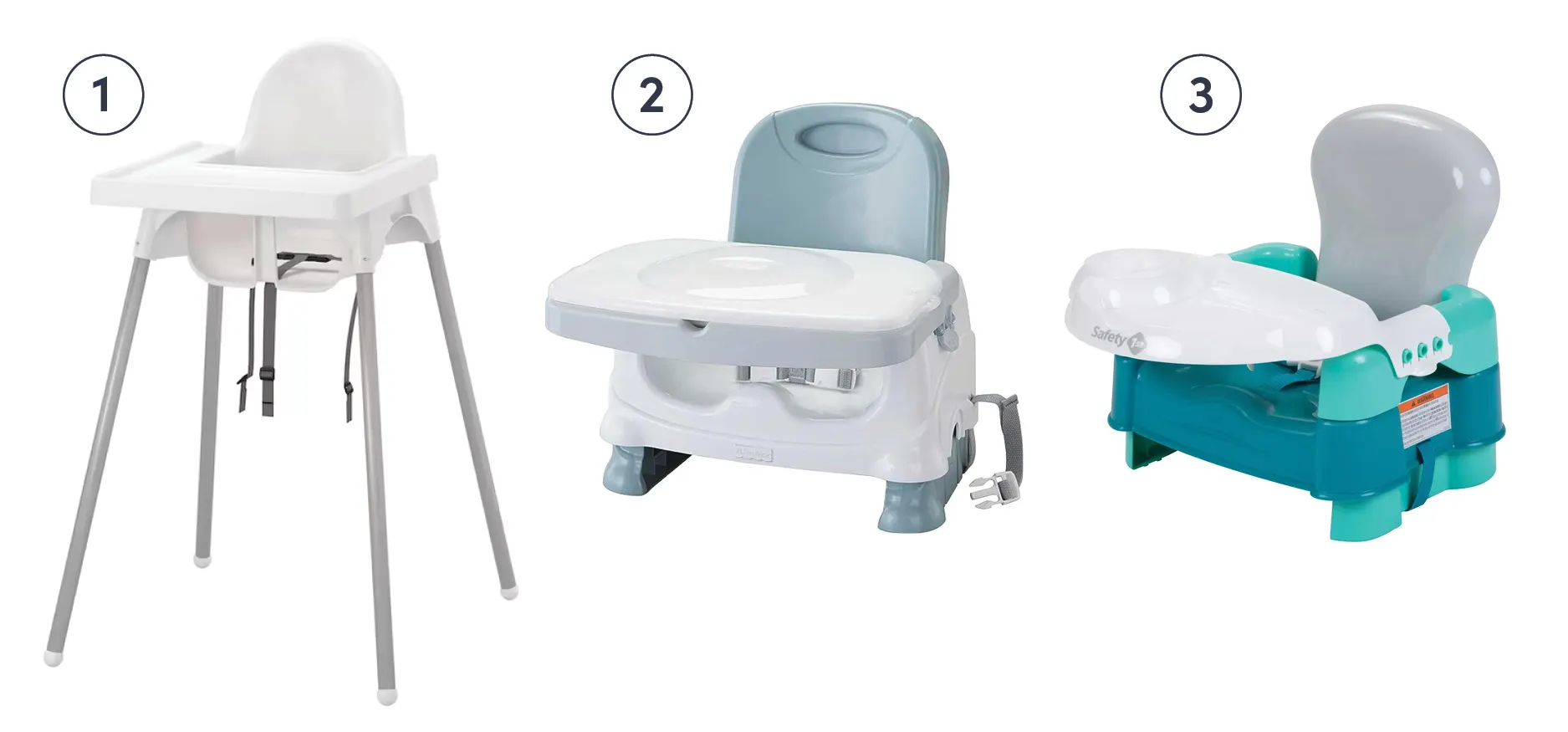
The following chairs are more affordable but do not meet our criteria for our top recommendations. Note: If you buy any of the chairs below, you will need another chair when baby grows out of it. Check out online and local consignment retailers for used and pre-loved chairs.
Best Booster Seats for Babies
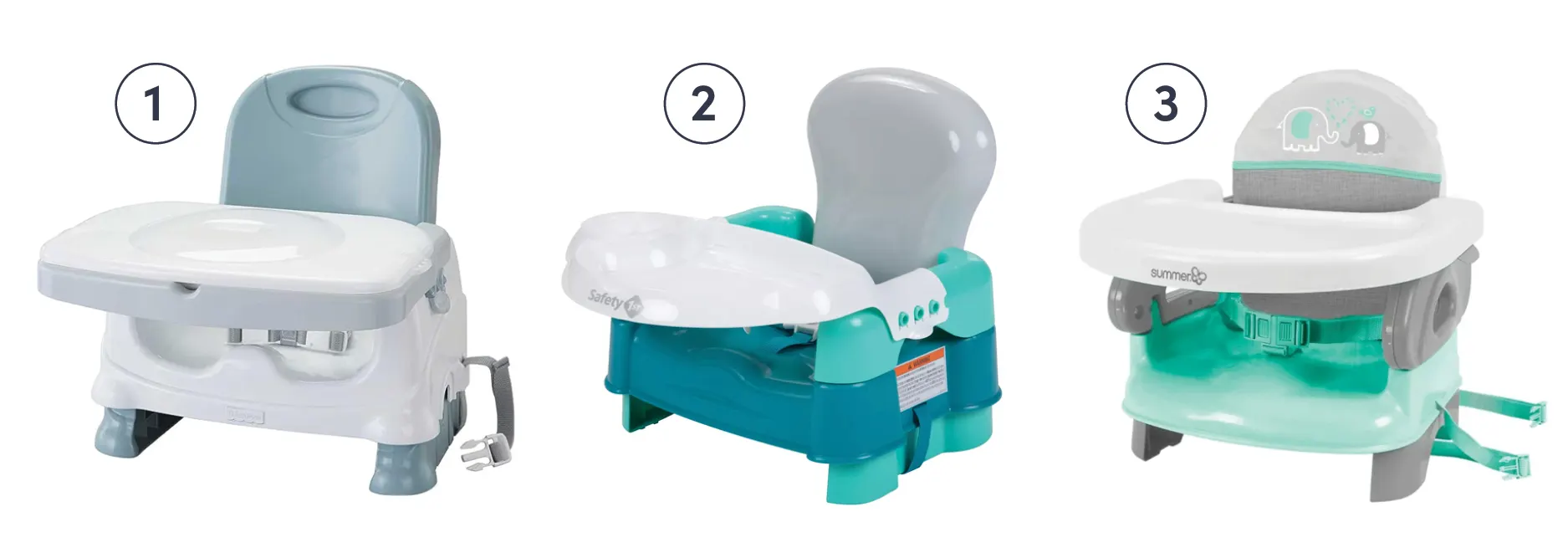
Best Clip-On High Chairs

Inglesina Fast Table Chair (with Wunderland High Chair Cover for ease of cleaning)
Best Space-Saver High Chairs

Best Travel High Chairs for Babies

**High Chair Recalls (in Calendar Year 2025)**
Harppa 5-in-1 Convertible High Chair
Date of recall: 10/30/2025
Consumer Contact: Call Harppa @ 844-796-8168, email at [email protected], or online at https://harppababy.com/pages/2025-harppa-high-chair-model-bhc001-voluntary-recall.
Bugaboo Giraffe High Chair
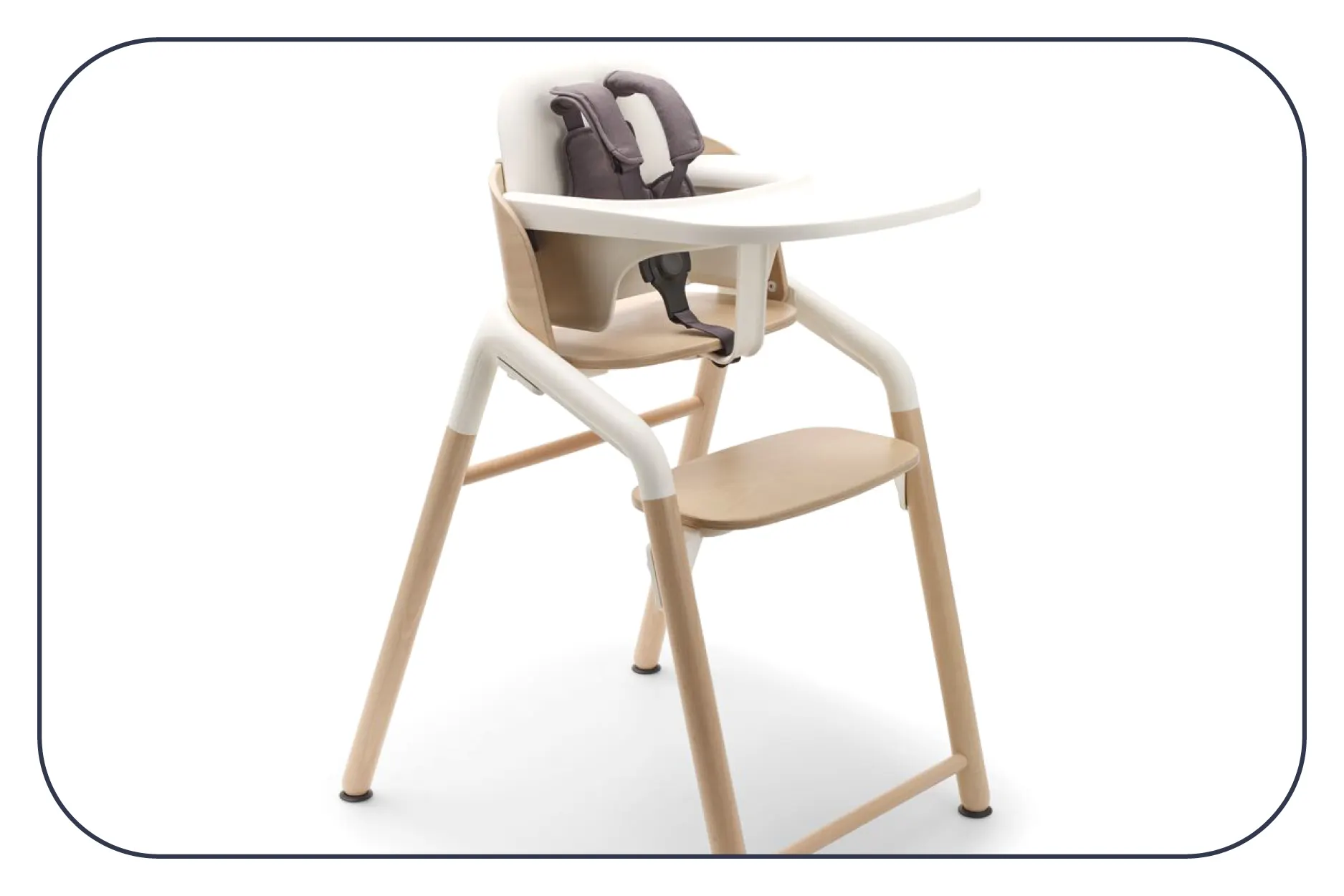
Date of recall: 06/12/2025 Consumer Contact: [email protected] or 800-460-2922

High Chair Positioning
Proper positioning at mealtime is important for swallowing safety and impacts baby’s ability to use their arms and hands and chew.
Proper positioning includes the following:
Back should be completely straight, shoulders in line with hips
Bent knees with the ability to bear weight forward into the feet
Ability to reach with the arms/hands to easily reach food on the tray
Weight forward, pressing through the feet
When baby sits upright with shoulders directly above the hips or leans slightly forward with weight bearing through the feet, gravity supports the tongue to move flexibly and better control the food in the mouth. In this position, food is more likely to move forward and out of the mouth if needed.
When baby is improperly positioned, including when a baby is reclined—even slightly reclined—their weight shifts backward, and gravity pulls in that direction. In other words, when baby is in a reclined position, food placed in the mouth is more likely to move backward toward the throat as gravity pulls in that direction. The tongue is also impacted by this gravitational pull, causing it to fall slightly back in the mouth and inhibit the tongue’s ability to control and manage the food.
Correct high chair positioning
The shoulders are in line with the hips or slightly forward, indicating baby's weight is centered over the hips or slightly forward.
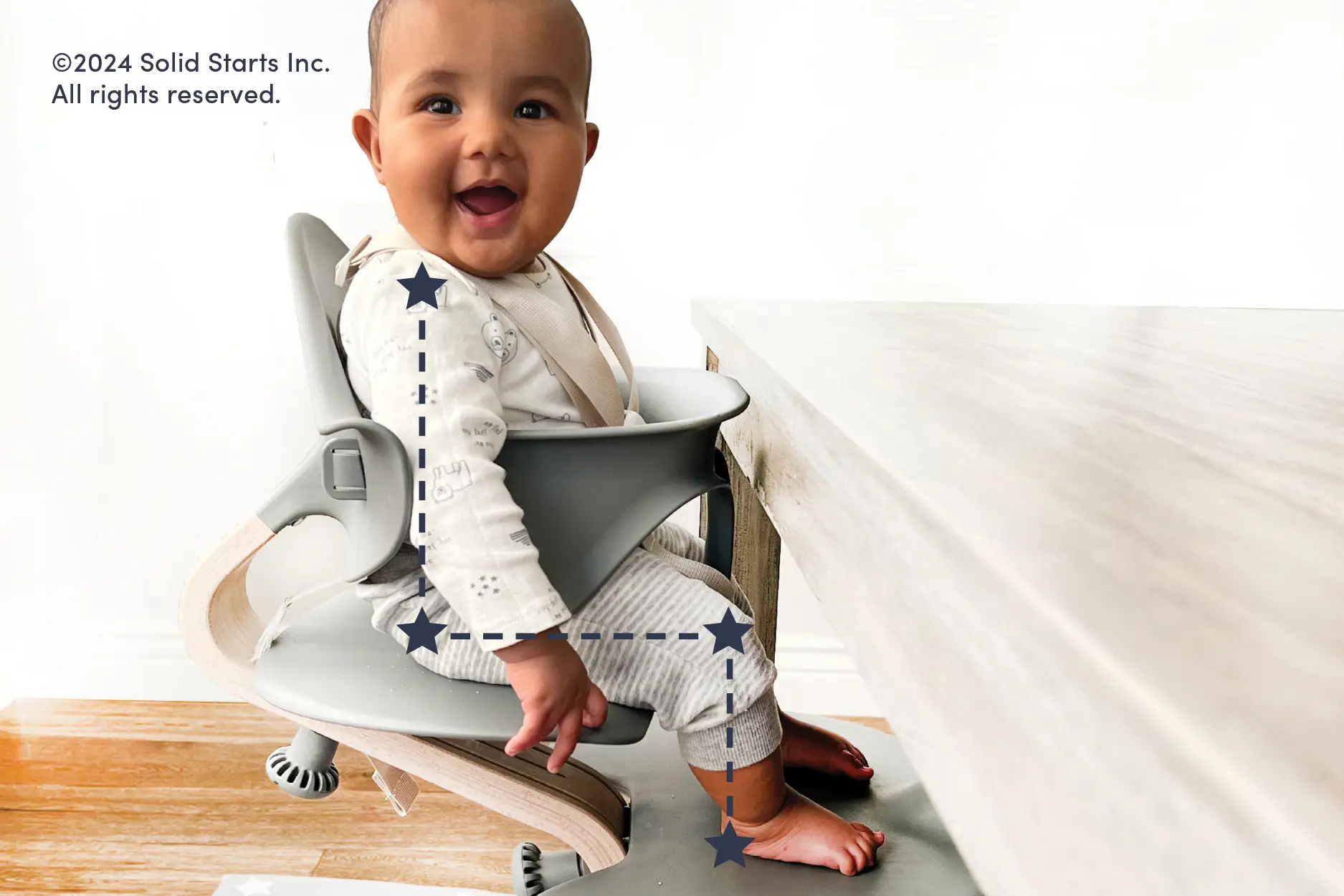
Incorrect high chair positioning: reclined
The shoulders are behind the hips, baby’s weight is behind them, and baby is reclined.
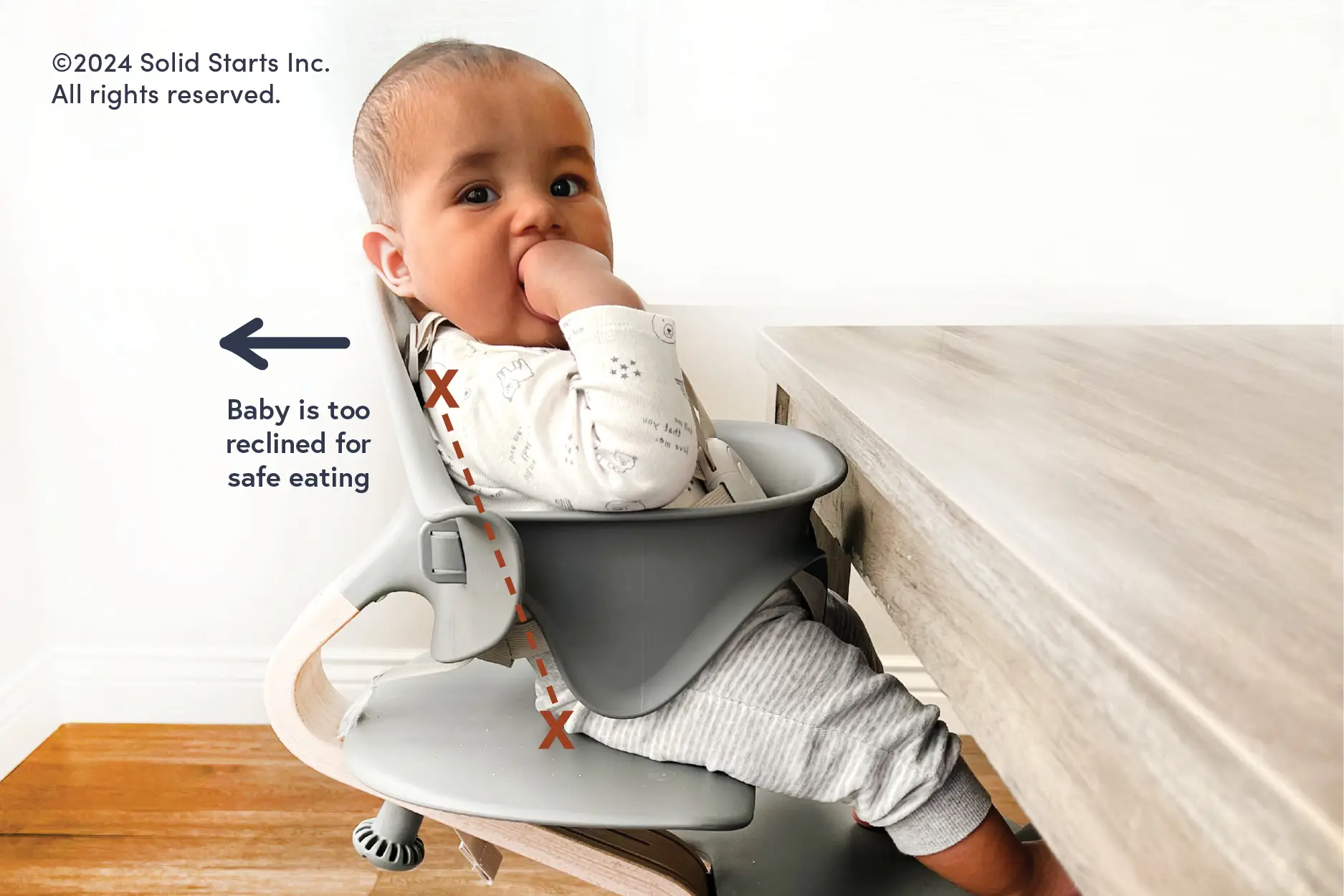
Incorrect high chair positioning: not developmentally ready
Baby is not developmentally strong enough to start solids if they frequently lose balance as they lean forward or if they are unable to lean forward and return to sitting without assistance. Baby is not developmentally ready.

Modifying High Chair to Better Support Baby
If baby can’t reach for the food...
If baby can’t pick up food on the table or tray, check to make sure their butt is high enough in the chair. Many babies gain upright stability with both forearms on the tray, and with the tray aligned at belly height rather than nipple height. If the table or tray is in line with, or only slightly below baby’s armpits, they need a boost.
Try placing a book underneath the butt to lift them in the high chair. The tray or table should align with the belly for the most biomechanical advantage for reaching and grasping. If baby struggles to hold themselves in the center with this boost, consider waiting a week or so before starting solids. You can also try a rolled-up towel or blanket to provide lateral support next to baby’s hips, which can help keep baby sitting in the center of the chair. Just keep in mind that if a lot of support is necessary, it may be best to wait until baby is stronger and showing more signs of readiness to start solids.
If baby is leaning in the chair...
It’s not uncommon for young babies to lean a bit when using their arms. Keeping the trunk engaged at the same time as reaching is hard work for a baby just figuring out how to sit independently. If the seat is very large or deep, even strong babies may lose their balance a bit.
Try using a rolled-up towel or blanket to provide some lateral support next to baby’s hips, which can help keep baby sitting in the center of the chair. If the chair is a good fit for baby and they still can’t sit upright, baby may need more time to develop strength before starting solids. In general, if a lot of support is necessary, it’s best to wait for signs of readiness.
If baby’s feet don’t touch the footrest...
For baby to reach the footrest, they need to sit upright with their weight shifted forward, the lower legs hanging, and knees bent at about 90 degrees. Before modifying the footrest, first assess baby’s upright sitting (see above). Babies often need to be scooted forward in the chair so their legs can hang.
Placing a folded or rolled-up blanket or towel behind baby’s back can make a big difference. After making any modifications to encourage correct positioning, adjust the footplate height to meet baby’s feet. Err on the side of too high over too low (knees bent more rather than less). Taping a small cardboard box, book, or yoga block to the footrest is a great way to raise the height. The goal is for baby to bear weight onto the footrest, so be sure any addition to the footrest is secure.

High Chair Safety Harnesses
An estimated 5,100+ infants are evaluated every year in emergency departments in the United States after falling from a highchair. High chair systems with straps or harness systems ensure a child is safe and secure. Always use high chairs as the manufacturer recommends, including properly securing safety straps or harnesses to keep a child safe and secure in their chair.
High chair harness systems are often designed as three- or five-point systems, with a waist strap and pommel or crotch strap, as well as additional straps over the shoulders.
For young babies, high chair harness straps are critical to ensuring the child is safe. At this age, high chair harness straps also assist in postural control, help the child remain totally upright, and prevent falls when baby is tired, overly wiggly, or playful. For the youngest babies, a five-point harness is ideal. Like a car seat harness, the shoulder straps keep baby from leaning forward and out of the seat. Young babies need to be stable, still, and secure when first learning to chew and practice swallowing food, and a five-point harness allows for the least amount of movement while the child is strapped in the chair.
For older babies and toddlers, harness straps aren’t necessary for postural control and instead help corral an active older baby and young toddler. As toddlers learn to stand and climb, the strapping system helps keep the toddler in the chair; this is also the time to consider transitioning to a more developmentally appropriate seating system. (See our guide Toddler High Chair Transitions.) This transition happens at different times for each child, depending on their temperament; some start trying to tip the chair and climb out around 12 months, while others do so around 18 to 24 months. If a child is actively trying to get out of the straps, rock out of the chair, or climb out while strapped in, teaching the child to sit safely without the harness is ideal.

High Chair Alternatives
A high chair or booster seat is not necessary to create a safe eating environment, and it does not always fit within one's food culture. For others, a high chair or booster seat can be a luxury that is out of reach financially. If purchasing a high chair or booster is not an option, here are some ways to ensure baby is as safe as possible when starting solids:
Seated on a lap
The easiest and free alternative to a high chair is having baby sit on an adult’s lap.
Position baby’s back against your body
Always keep one arm around their waist
Scoot your chair as close to the table as possible with baby facing the table
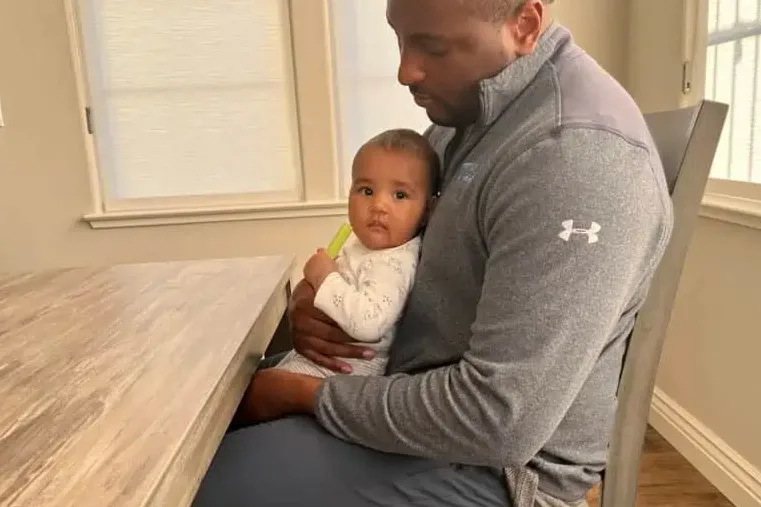
Make sure baby is sitting high enough so that both of baby's forearms rest comfortably on the table in front of them. If the table is in line with their armpits, baby is too low. Try sitting on a pillow to boost yourself (and subsequently, baby) in the chair. Avoid placing a pillow in your lap for baby to sit atop. Optionally, you can allow baby to straddle one thigh and let baby’s feet firmly plant on the chair.
Seated on the floor with support
Positioning baby on the floor with support is another option:
Position baby’s back against your body
Support hips with both hands
Place baby’s legs in a “ring sit” shaped like a circle, bottom of feet facing each other
Use a shoe box to elevate the food or plate to belly button level or slightly above

How to make an old high chair safe
Old or vintage high chairs may be okay, depending on the type, or may need some modifications to get baby in proper positioning. Here are some common adjustments often needed for old or vintage high chairs.
Seat size: Many vintage chairs have a very large seat, without any strapping system or harness. A small baby or one slightly unsteady in sitting will need additional support to sit upright and stay upright.
An older baby or toddler, like Maeve (13 months) above, can likely sit without much additional support. However, if baby cannot sit strongly, consider using towel or blanket rolls next to baby on each side to keep them sitting safely.
Additionally, old high chairs might require adjustments to the height of the footplate. Use footplate adjustments discussed above.

Frequently Asked Questions

High Chair Reviews
Solid Starts is an independent organization that does not accept money or free products in exchange for reviews. Any recommendations here are our own opinions. If you choose to shop through retailer links here, we may earn a small affiliate commission. Commissions earned go to our First Foods® database and economic need program.
Abiie Beyond
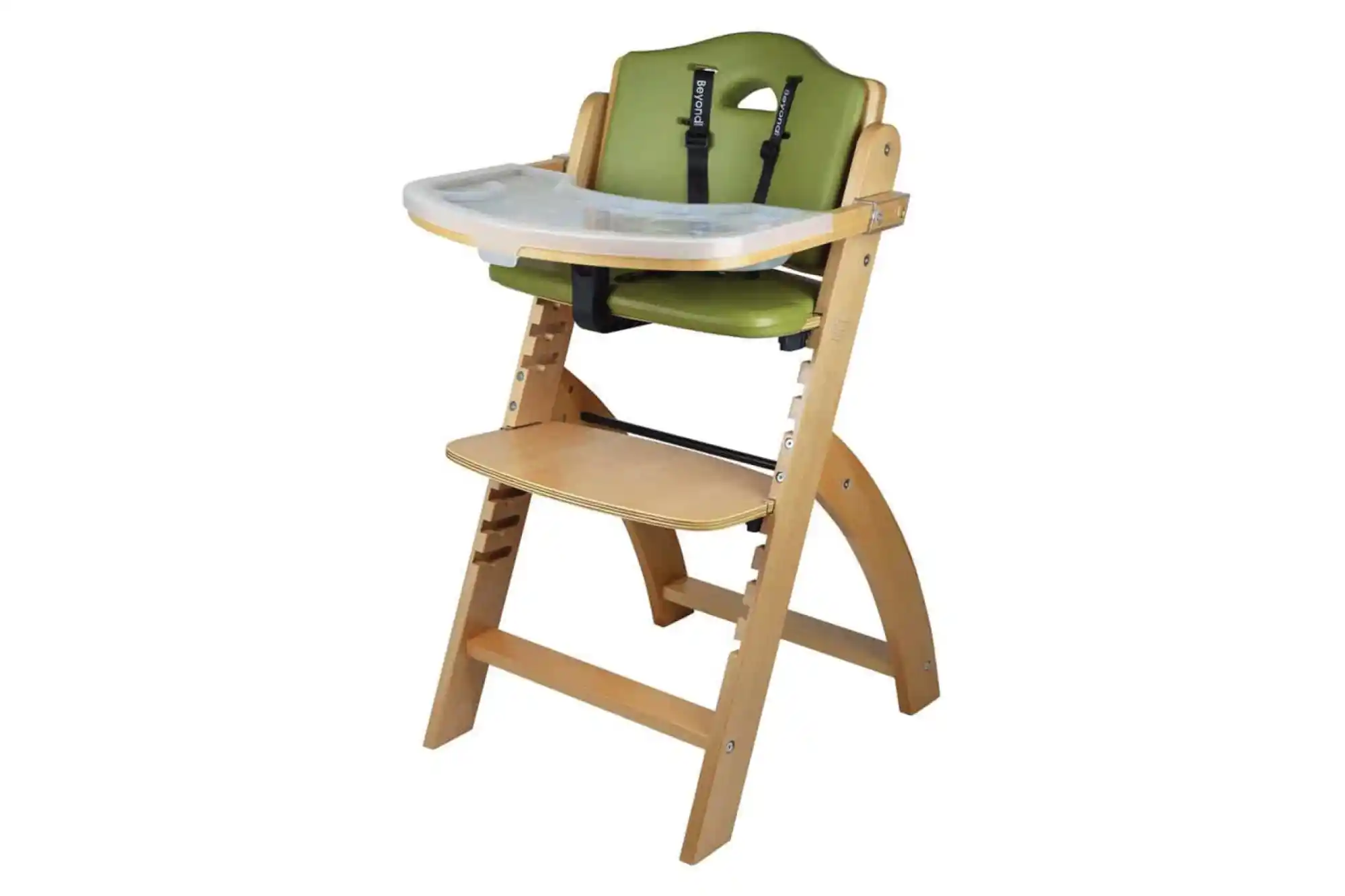

Upright Seat | Yes |
Adjustable Footrest | Yes, but not ideal* |
Tipping | Minimal |
Tripping | Minimal |
Removable Tray | Yes |
Max Age | Early Childhood** |
5-Point Harness | Yes |
Easy to Clean & Adjust | Moderate |
* The Abiie Beyond footrest is adjustable, but it does not stick out far enough for baby to place their entire foot on it.
** The Abiie Beyond does not contain a bucket seat for support, which means they may need to be used with the tray until they can sit in an open, adult-style chair.
This wooden chair was designed to be a less expensive version of the Stokke Tripp Trapp chair and while it offers good positioning, it has a major flaw: it lacks an infant bucket seat. This means that for young babies, the chair must be used with the tray intact at all times for optimal support and safety. It also means the chair cannot be brought right up to the table to eat with adults in the family. For smally and/or wiggly babies, this chair may not be supportive enough. That said, the chair is easy to use, sturdy, and grows with the child. It is relatively easy to clean (though expect some food to get caught between the seat cushion and wood) and the straps, unlike the Stokke Tripp Trapp chair, are easy to clean and adjust. The chair has a relatively small footprint making it less likely for a caregiver to trip over it and a good option for small spaces.
Pros
Good positioning with an upright seat and adjustable footplate
Grows with the child and will be an excellent toddler chair
Sturdy but small footprint
Cons
Lacks an infant bucket seat and may not be supportive enough for small babies
Cannot be pulled up to the table without the tray until the child is strong enough to sit with less support
Tray is small and may not fit many suction plates
Dream on Me Nibble 2-in-1 High Chair
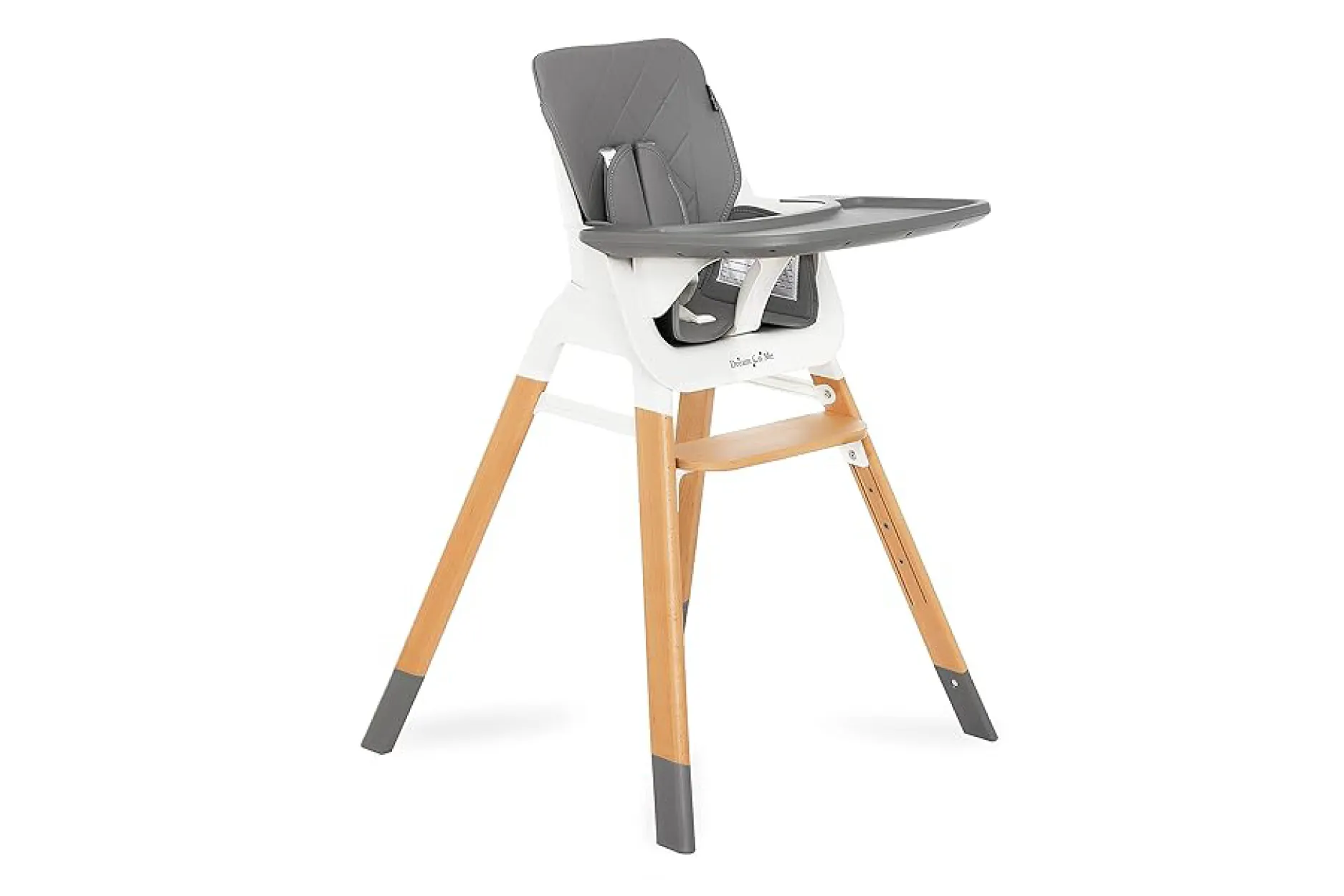
This chair has wooden legs and a stable plastic seatback with removable colorful seat covers. It weighs about 13 lbs and includes a five-point safety harness. It features a smaller, four-position adjustable footrest, which works well for an older or taller infant and toddler but is often not high enough for many young infants. With a blanket roll for additional support along baby’s back, baby may be able to sit forward enough in the chair to allow the knees to bend adequately. The footplate is the right size for a pasta box to sit on top and raise the height of the footplate until baby can reach it independently. The seat is completely upright and slightly higher profile than the Stokke and Nomi chairs. Once turned into a toddler chair, the seat is very low profile and looks more like a stool, which can hold up to 55 lbs. The tray is removable, and the chair easily pulls to the family table.
Pros
Fairly good positioning but requires some modifications for younger or smaller infants
Easy to wipe down
Transitions into a toddler stool
Cons
Footplate is smaller and not fully adjustable
Shoulder pads are not removable and a little bulky for young babies
Toddler stool is less supportive than other transitional high chairs
Ergo Baby Evolve
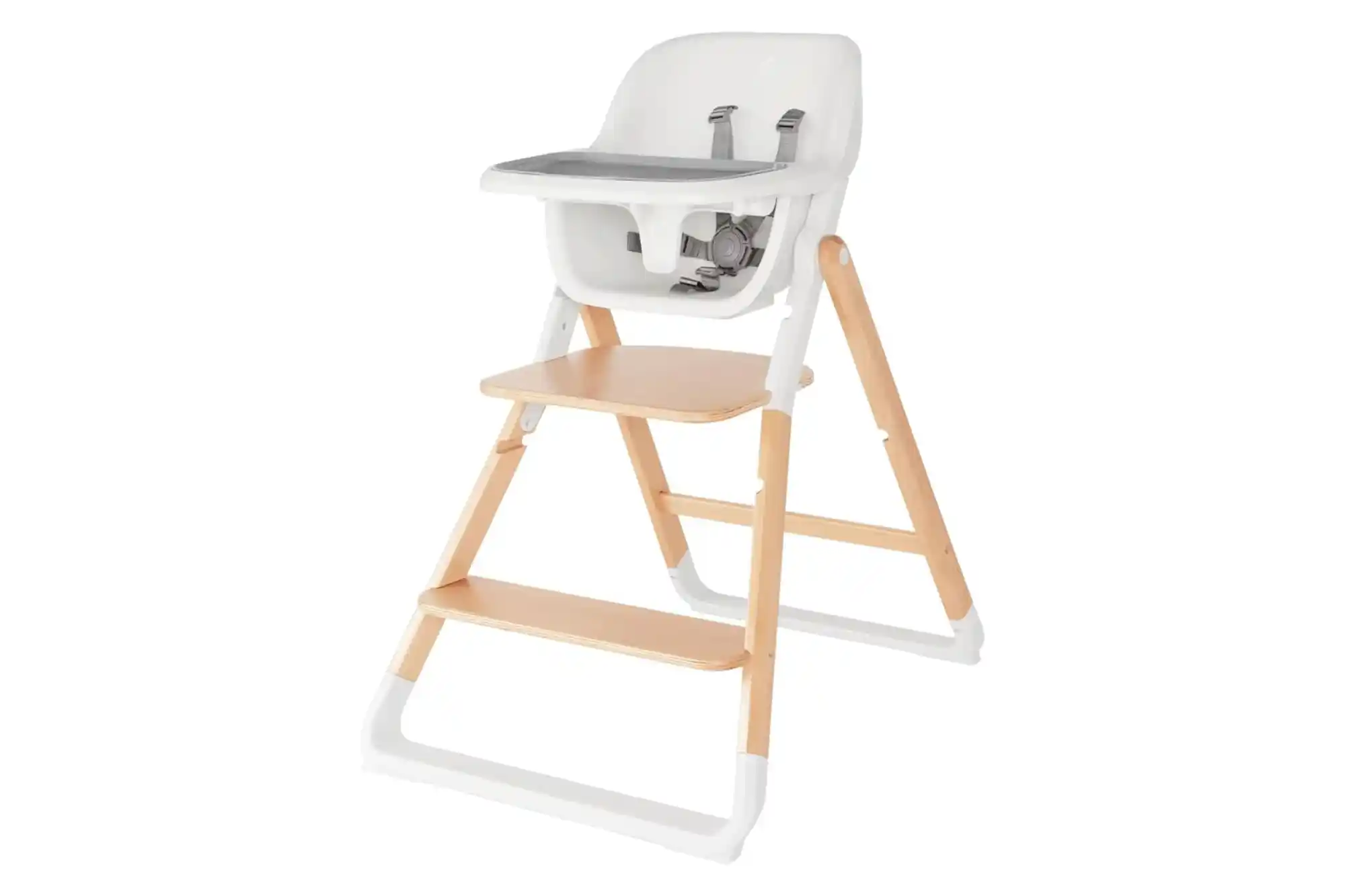

Upright Seat | Yes* |
Adjustable Footrest | Yes** |
Tipping | Minimal |
Tripping | Minimal |
Removable Tray | Yes |
Max Age | Early Childhood*** |
5-Point Harness | Yes |
Easy to Clean & Adjust | Yes |
* The Ergo Baby Evolve chair does not contain bucket seats for support, which means they may need to be used with the tray until they can sit in an open, adult-style chair.
*** The Ergo Baby Evolve seat is deep and large, so small babies may need a rolled-up towel or blanket behind them for support.
** The Ergo Baby Evolve footrest has only two positions, so the footrest may not work well for toddlers and preschoolers between settings.
The Ergo Evolve chair is a beautiful but expensive chair. It offers excellent positioning for the hips, legs and body though it lacks a harness in the bucket seat which means that for young babies, the chair must be used with the tray intact at all times for optimal support and safety. It also means the chair cannot be brought right up to the table to eat with adults in the family as the tray will be in the way. That said, the chair is easy to clean (including the straps) and folds up easily and is lightweight to carry.
Pros
Good positioning with an upright seat and adjustable footplate
Grows with the child and converts into a toddler chair
Folds up easily for storage
Cons
Less sturdy (because it's so lightweight)
Large, wide footprint which may cause caregiver tripping
Assembly takes time
Lalo the Chair
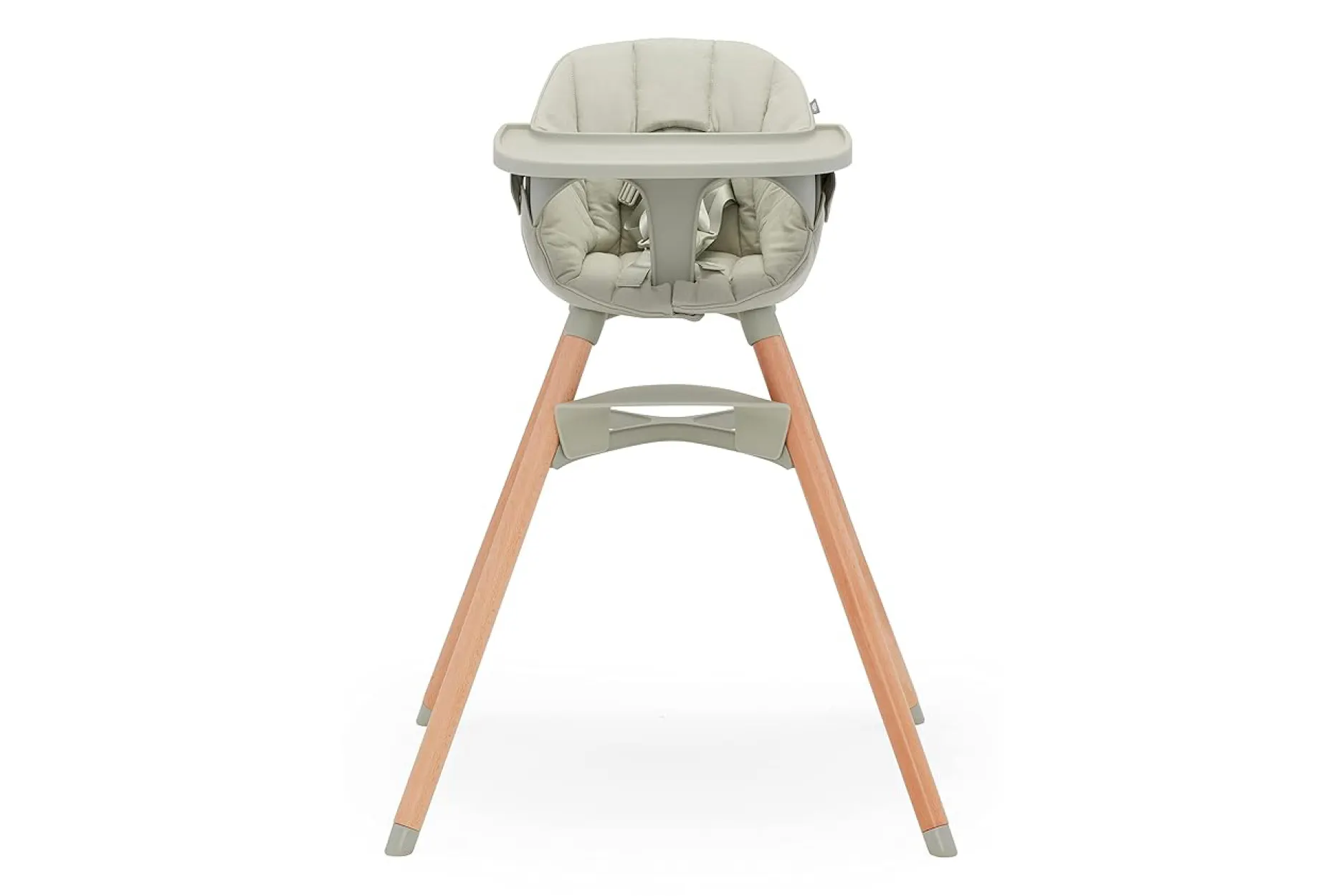

Upright Seat | Yes |
Adjustable Footrest | Yes |
Tipping | Minimal |
Tripping | Minimal |
Removable Tray | Yes |
Max Age | Early Childhood* |
5-Point Harness | Yes |
Easy to Clean & Adjust | Yes |
Lalo the Chair has wooden legs and a plastic seatback with removable colorful seat covers. It’s very lightweight at roughly 10 lbs and includes a fully WIPEABLE five-point safety harness. The footrest is not fully height-adjustable, which may work fine for an older or taller infant and toddler, but it’s often not high enough for most infants.
The footrest is small, so a pasta box may be suitable to raise the footplate height for a smaller baby. The seat is upright and slightly higher profile than the Stokke and Nomi chairs, with a machine-washable cushion. There is an infant insert that can be purchased for the seat that makes the chair better fitted for a small baby. Without the insert, baby may need a back support with a towel or blanket roll to sit completely upright in this chair. The tray is removable, and the chair easily pulls to the family table. The chair converts to a low child play chair and can hold up to 200 lbs.
Pros
Removable tray and pulls up to the table
Transitions into a toddler chair and toddler play chair
Infant insert helps with posture in the chair
Wipeable harness system
Cons
Footplate is not fully adjustable and is small
Wide footprint/legs
Mockingbird High Chair


Upright Seat | Yes |
Adjustable Footrest | Yes |
Tipping | Minimal |
Tripping | Minimal |
Removable Tray | Yes |
Max Age | Early Childhood* |
5-Point Harness | Yes |
Easy to Clean & Adjust | Yes |
* Without the infant seat, the Mockingbird High Chair has a weight limit of 150 lbs (68 kg).
A fantastic chair at a moderate price, the Mockingbird supports baby’s journey at the table from infancy through early childhood. The chair has excellent positioning for safety at mealtime and an easy-to-adjust footrest. It also has a smaller footprint than many high chairs on the market. Lastly, the chair (and straps!) are exceptionally easy to clean.
Compared to other high chairs, the Mockingbird High Chair is lightweight, weighing around 16 lbs (7 kg) with the infant seat. A 5-point harness system with easy on magnetic buckle keeps baby safe at mealtime, while the seat positions their body with the appropriate trunk, pelvic, and lower body alignment. Baby is positioned with only the upper thigh on the seat, which allows the knees to bend appropriately, with the lower legs hanging down and the feet able to bear weight on the footrest. The footplate has four options to position baby. The positions may be slightly too low or too high at times as the child grows, though the chair typically offers adequate support through the in-between phases. When using this chair, we recommend erring on the side of the knees bending too much rather than the feet just barely touching. The tray is easily removed, and the chair easily pulls to the family table. This chair looks just like a standard chair, and without the infant seat, it can hold up to 150 lbs (68 kg).
Pros
Excellent positioning
Easy to set up, adjust, and clean
Transitions into a fantastic chair for toddler and young children
Cons
Cost
Chair sits a bit higher than a standard adult chair (may not fit height of dining table)
Footplate adjustment options are sometimes too high or too low
Nomi High Chair
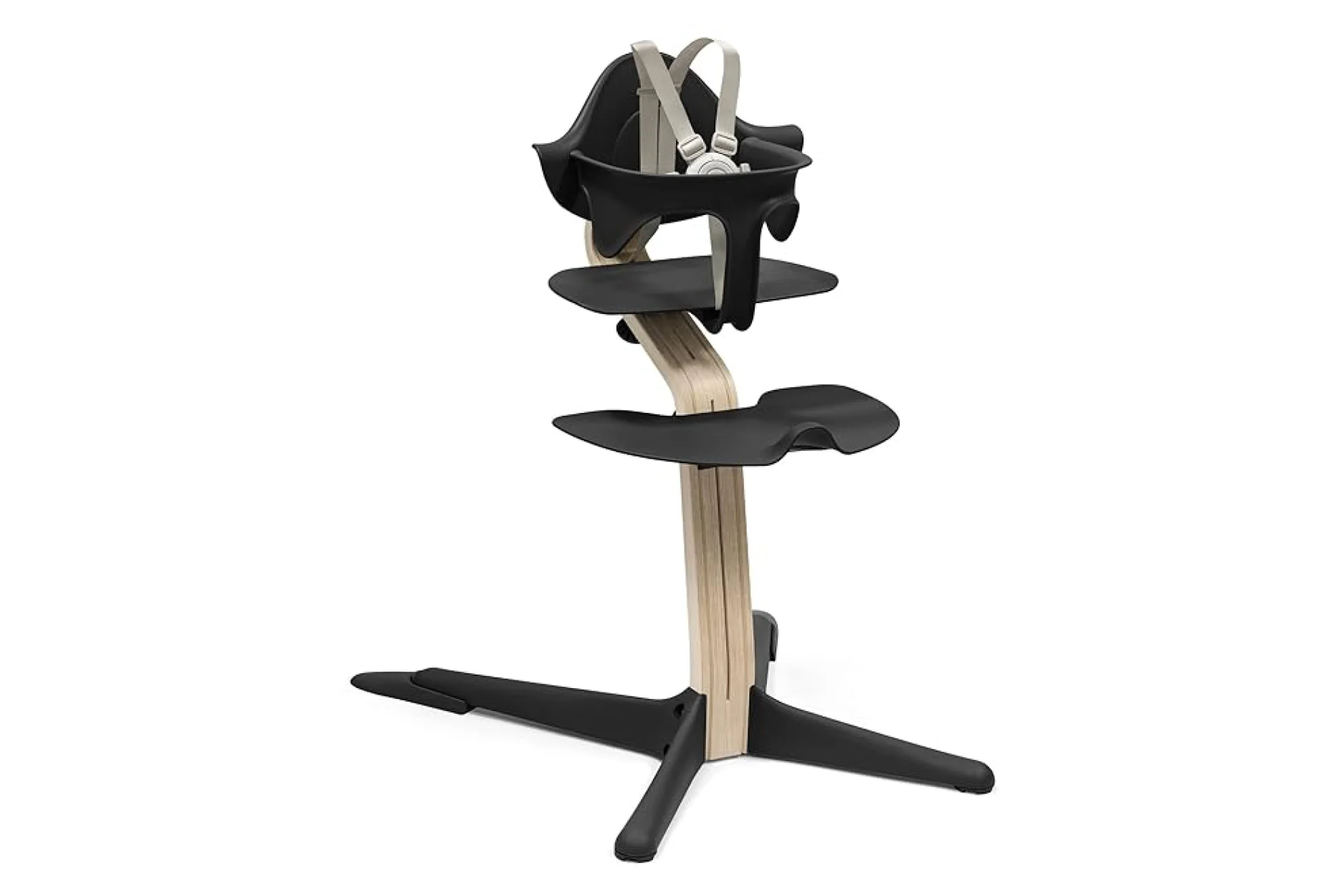

Upright Seat | Yes |
Adjustable Footrest | Yes |
Tipping | Minimal |
Tripping | Moderate |
Removable Tray | Yes |
Max Age | Early Childhood |
5-Point Harness | Yes |
Easy to Clean & Adjust | Moderate |
This high chair is made to grow with the child from infancy with an infant insert and into childhood. With a significantly smaller seat and a base that often must be tightened to keep stable, the Nomi is less sturdy than other chairs on the market. The chair itself weighs about 13 lbs and has a fairly large footprint. What it lacks in sturdiness, Nomi makes up for in a fully height-adjustable footplate, which easily slides up and down to meet baby’s feet.
The chair offers excellent positioning, with a completely upright seat for appropriate trunk, pelvic, and lower body alignment. The five-point harness system is complicated and takes some practice to learn how to clip. However, unlike the Stokke chairs, the harness is still usable when the infant bucket attachment is removed, which benefit toddlers slowly transitioning to sit without the safety supports. The tray is removable, and the chair easily pulls to the family table. For some smaller babies, the infant bucket seat is still a bit big with room for a baby to lean from side to side, especially with the tray removed. This chair, without the infant insert, can hold up to 330 lbs.
Pros
Excellent positioning
Easy to clean (with the exception of fabric straps)
Transitions into a good toddler chair while continuing to use the straps.
Straps are easy to adjust
Cons
Cost
Seat is a bit narrow and young toddlers may fall off when straps are not used
Screws on foot stand can come loose and the chair is sometimes wobbly
Harness clips somewhat difficult to close, but offer quick-release
Skip Hop EON 4-In-1 High Chair
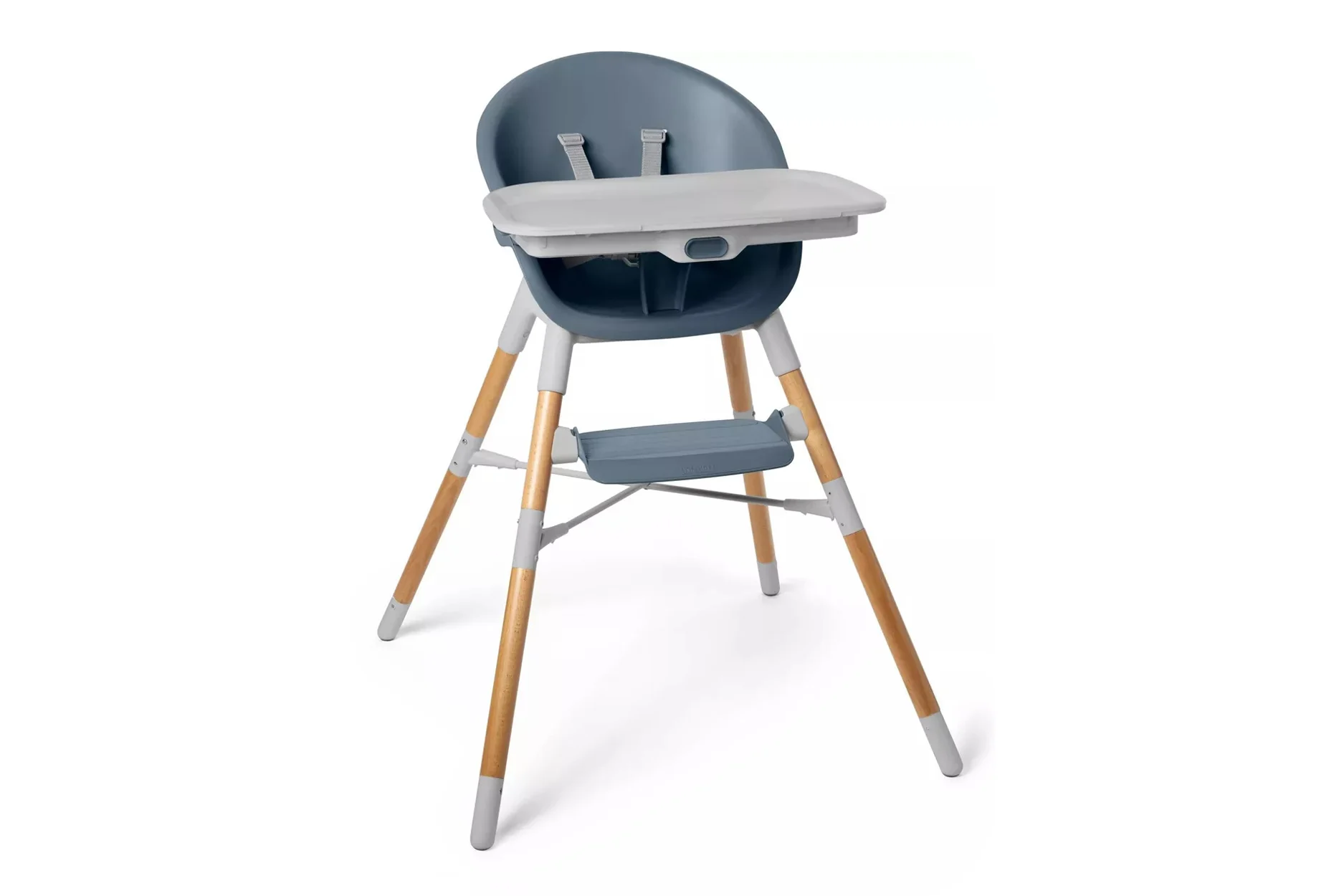
This chair has wooden legs and a plastic seatback with a removable five-point safety harness. This chair weighs about 12 lbs. The footrest is adjustable, but only to two heights, which may work fine for an older or taller infant and toddler, but it’s likely not high enough for many infants. The infant insert is slightly big for smaller babies. The seatback is slightly reclined—for many older infants and toddlers, this is unlikely to affect pelvic alignment, but a young infant will likely need a blanket or towel roll to help baby sit completely upright with the shoulders in line or in front of the hips. The tray is removable. This chair also converts to a low child play chair and is rated to hold up to 80 lbs.
Pros
Easy to wipe down
Transitions into a booster seat and toddler chair
Straps can be used without the infant insert
Cons
Seat is slightly reclined, and most babies will initially need postural support (blanket roll) behind them
Footplate is smaller and not fully adjustable
May be too tall when pulled up to a standard-height dining table
Stokke Clikk
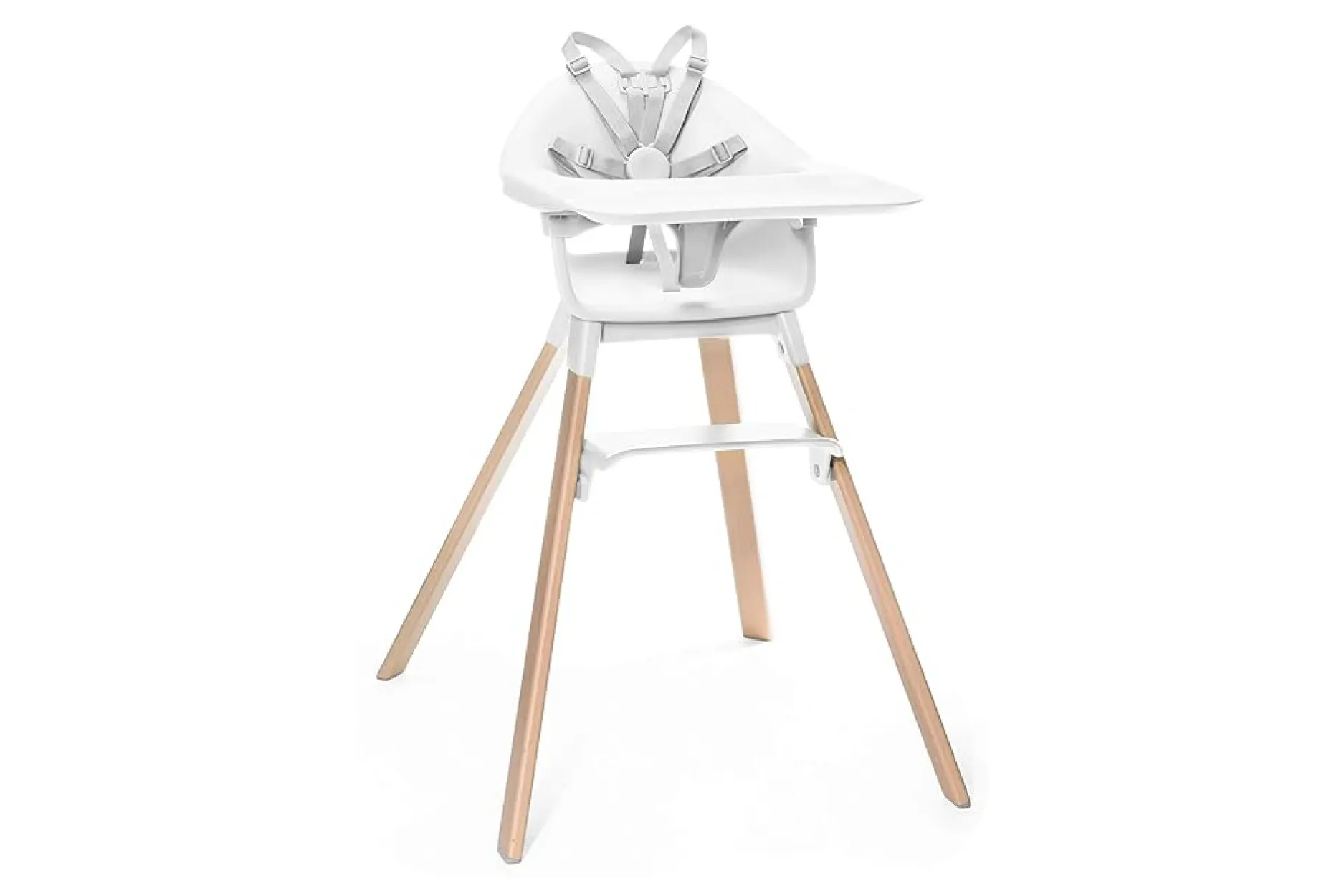
The Clikk is a slightly less expensive, lightweight (about 10 lbs) option by Stokke with a similar design to the Lalo chair. It comes with a five-point harness and tray table, and the seat is completely upright. It’s appropriate for children up to age 3 (max weight of 33 lbs). The footrest has two positions, but it is likely too low for a small baby to reach and requires the need for a box or other adjustment. The straps are removable and machine washable, and the entire chair is plastic and can be wiped down.
Pros
Lightweight, easy to put together, made for traveling (with travel bag)
Upright seat
Comes with tray, don’t need to purchase separately
Cons
Footrest not fully adjustable; likely won’t work for smaller babies.
Slightly wide footprint could be tripping hazard for parents
Only safe for up to 33 lbs, will need new seating system after age 3
Stokke Tripp Trapp
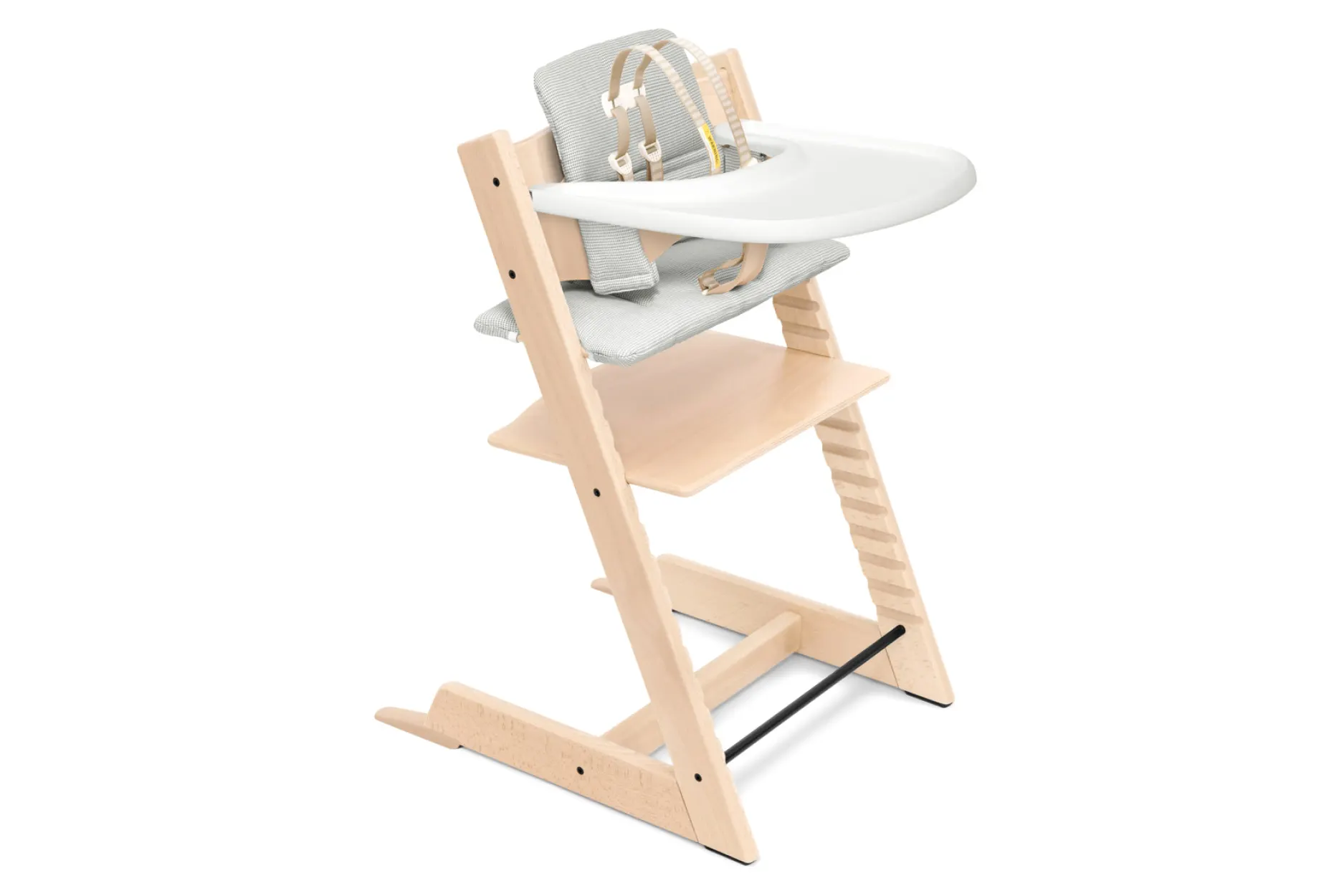

Upright Seat | Yes |
Adjustable Footrest | Yes |
Tipping | Minimal |
Tripping | Minimal |
Removable Tray | Yes |
Max Age | Early Childhood |
5-Point Harness | Yes |
Easy to Clean & Adjust | Moderate** |
** While the wooden parts of the chair are fairly easy to clean, the straps are not.
A best-seller around the world, the Tripp Trapp chair offers excellent positioning and longevity in terms of how long you can use it. However, the chair is not without its flaws: it is difficult to assemble, difficult to adjust, and the flat, wooden seat is not as comfortable as other chairs that have a more contoured design.
The Stokke Tripp Trapp is a wooden high chair featuring a large, fully height-adjustable footplate. This chair is designed to grow with the child from infancy with an infant insert and into childhood. The seat can also be adjusted to the size of the child, allowing you to slide the seat forward or backward to make sure baby is snug. This chair is sturdy, weighs about 15 lbs, and has a completely upright seat for appropriate trunk, pelvic, and lower body alignment. The Tripp Trapp also includes a five-point harness system that accompanies the infant attachment.
The biggest perk of this chair is that the seat depth is fully adjustable and, by moving the seat, you can make sure baby is positioned with their back against the seatback while allowing the knees to bend at 90 degrees. The tray is removable, and the chair easily pulls to the family table. The chair without the infant insert can hold up to 242 lbs. For some smaller babies, the infant bucket seat is still a bit big, and there is a lot of room for a baby to lean from side to side, especially with the tray removed. The harness is complicated to adjust, wash, and fit.
Pros
Excellent positioning and sturdy
Transitions into a good toddler chair
Adjustable seat and footrest
Cons
Not easy to set up or adjust
Straps are difficult to clean and adjust
Food gets stuck in many little corners and indentations
Cost
UPPAbaby Ciro High Chair


Upright Seat | Yes* |
Adjustable Footrest | Yes** |
Tipping | Minimal |
Tripping | Minimal |
Removable Tray | Yes |
Max Age | Early Childhood |
5-Point Harness | Yes |
Easy to Clean & Adjust | Yes |
* The UPPAbaby Ciro chair does not contain an infant bucket seat, which means smaller, less stable babies may be safer with the tray for a few weeks to months. The seat is also deep and large, which means smaller babies may need a rolled-up towel or blanket behind them for support.
** The UPPAbaby Ciro footrest has only two positions, so the footrest may be too low for a smaller baby.
A sleek chair at a moderate price, the UPPAbaby Ciro High Chair offers good positioning for the hips, legs and body. While the chair does not offer an infant bucket seat, it does feature a plastic divider to keep the legs supported. Just keep in mind that the seat is on the larger side, so smaller babies may need additional support to sit close enough to the tray. The footplate can be adjusted as baby grows, but there are only two heights.
This chair’s footprint is a bit wider than others (which can help prevent tipping) and the legs are designed to easily skid on the floor if it needs to be moved. The best part: both the chair and straps are very easy to clean.
Pros
Good positioning with an upright seat and adjustable footplate
Easy to clean
Easy adjust straps
Cons
Lacks an infant bucket seat
Only two positions for the footrest
Does not convert into a toddler chair
Reviews: Space-Saving High Chairs and High Chairs for Table Tops
Various chairs on the market are made for small spaces, some of which are suitable for the floor, on a regular dining chair like a booster seat, or on a countertop. Below are some of the most popular space-saving high chairs. Keep in mind that these chairs lack some crucial safety components for starting finger foods. Please read the sections above for how to modify chairs for safety.
Fisher-Price SpaceSaver Adjustable High Chair

This low-cost high chair is a popular option for families with small spaces. Unfortunately, the seatback is slightly reclined, even when adjusted to the most upright position. It comes with a five-point safety harness, removable tray, machine washable seat cover, and transitions into a booster seat. When sitting in the Fisher-Price SpaceSaver, a baby’s knees tend to lay straight, supported by the chair seat, and there is no footrest. The max weight for this chair is 50 lbs.
Pros
Inexpensive
Small
Portable
Cons
Seat not completely upright, baby’s position not ideal for efficient chewing and safe swallowing
No footrest and no easy way to position feet for weight-bearing, especially for small babies
May be too small to bring baby to the table on a dining chair (too low for the table)
Fisher-Price Healthy Care Booster Seat & Safety 1st Sit, Snack & Go Booster Seat
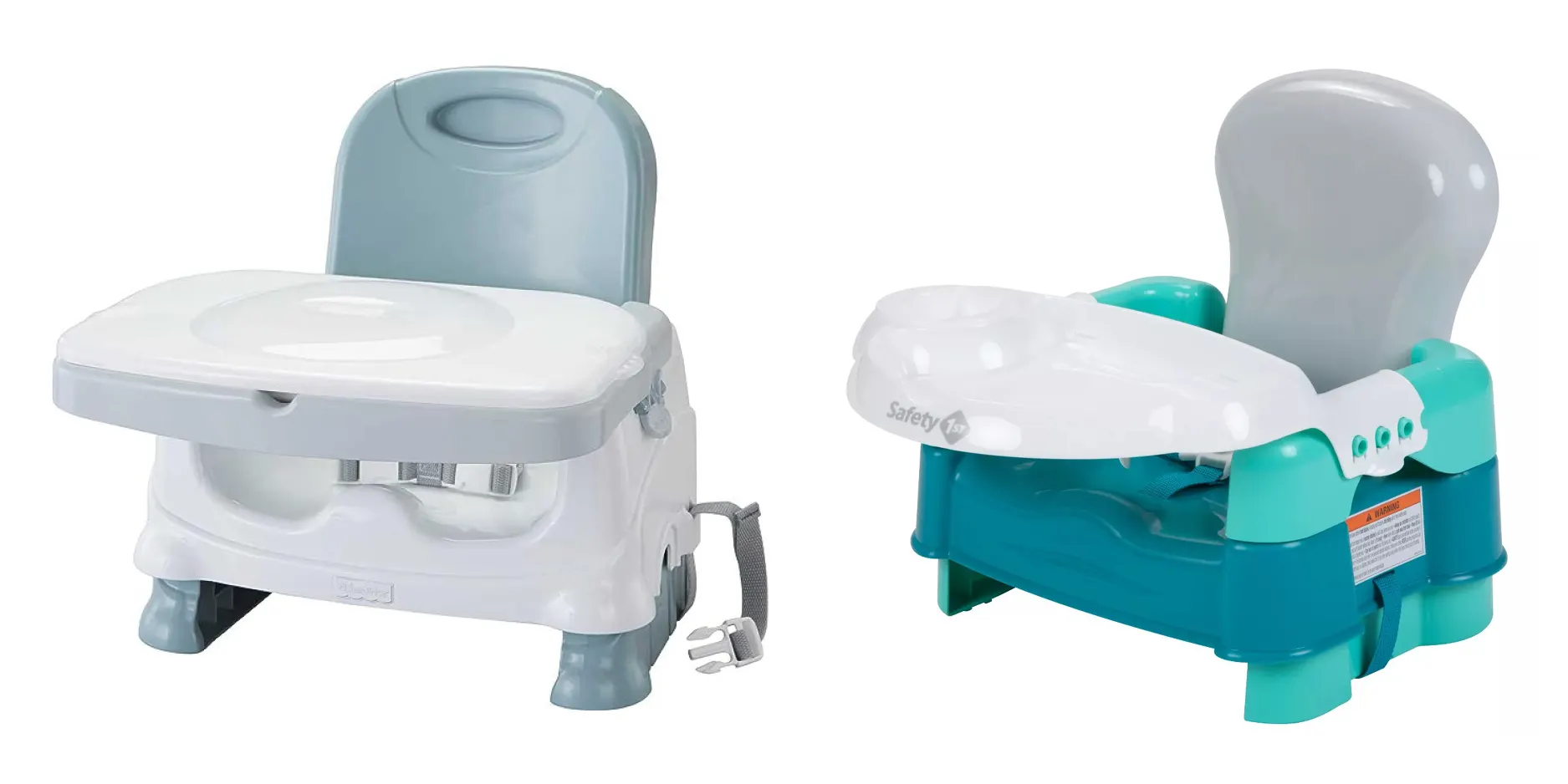
These low-cost chairs are another popular option for families with small spaces. They come with a three-point safety harness, removable trays, and transition into booster seats. The seatbacks are completely upright. When sitting in these chairs, a baby’s knees tend to lay straight, supported by the chair seat, and there is no footrest. The max weight for these chairs is 50 lbs.
The Fisher Price seat has three trays and folds up to easily carry like a bag. The Safety 1st has two levels of booster height, but the seatback is smaller and less supportive.
Pros
Inexpensive
Small
Portable
Upright seat
Cons
No footrest, requires modifications to get baby to weight bear through the feet
Only three-point harness
Ingenuity Baby Base 2-in-1 Booster Feeding and Floor Seat with Self-Storing Tray & Bumbo Multi-Seat
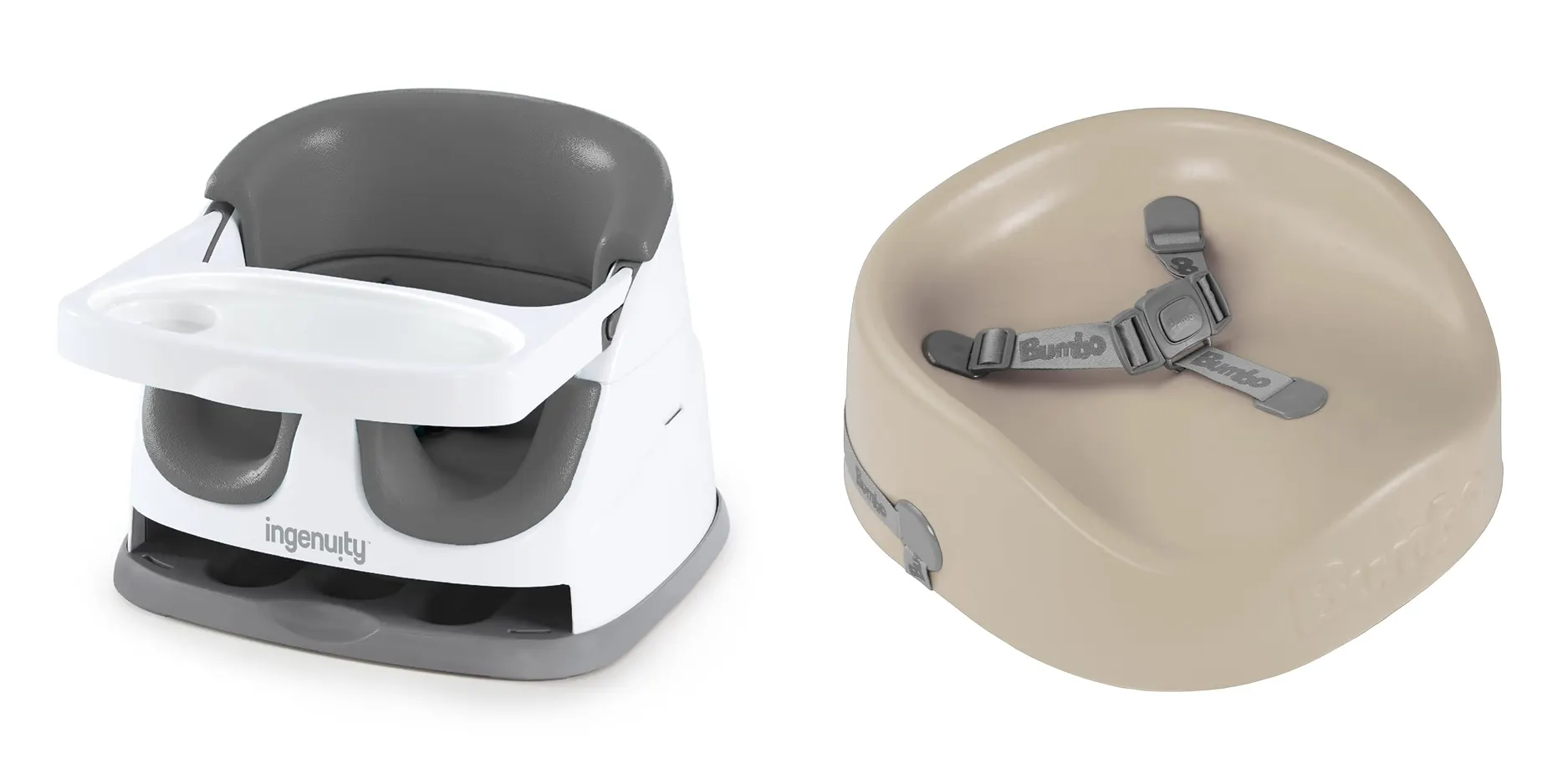
These low-cost seats are popular chairs and commonly used as infant positioning devices. They come with a three-point safety harness, a removable tray, and transition into booster seats. The seatbacks are upright but curved. The seat is a bucket seat, and baby’s bottom may sit lower than their thighs and knees, which is not ideal for sitting posture. There is no footrest. The max weight for the Ingenuity chair is 50 lbs, and Bumbo is 30 lbs.
Pros
Inexpensive
Small
Portable
Cons
No footrest, requires modifications to get baby to weight bear through the feet (including back support)
Only three-point harness
Bucket seat can put baby in improper pelvic alignment, which is not ideal for chewing and swallowing
Inglesina Fast Table Chair
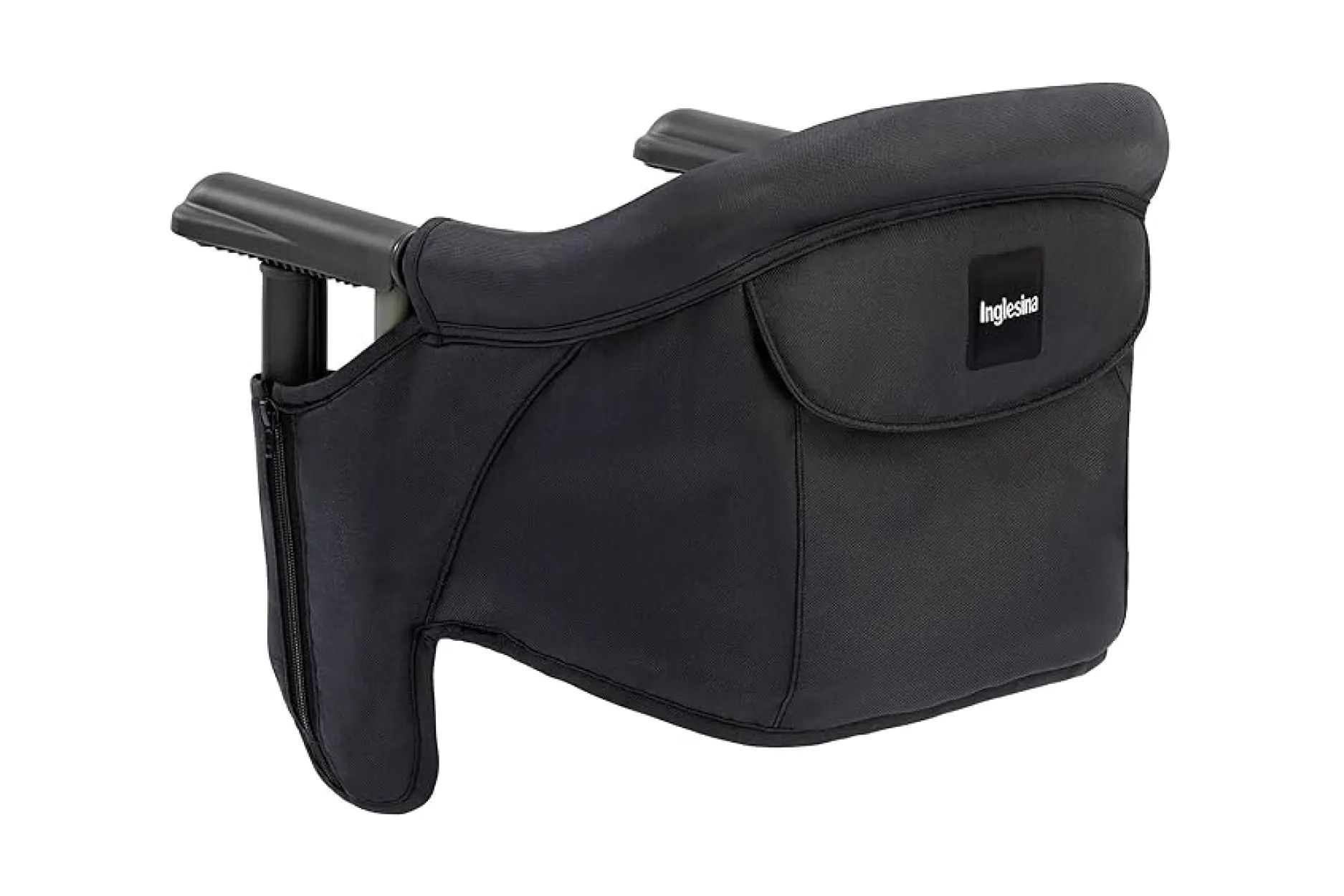
This popular travel high chair hangs from a table or countertop, and is commonly used when eating out. It has a three-point harness, removable tray table, and firm plastic seat. It is fabric-covered and hand-washable. The seat is large enough for a toddler but provides too much room to support good postural stability for many small babies. There is no footrest, but the Inglesina can hang over another chair to use for bearing weight through the feet. The max weight for this chair is 37 lbs.
Pros
Very portable, easy to use for travel
Great for small spaces, can be used with an existing table or countertop
Cons
No footrest and poor postural support, especially for smaller babies
Difficult to clean
Should only be used on strong, reliable table or countertop
Lalo Hook-On High Chair

Lalo has upped the ante when it comes to high chairs for small spaces or travel. The chair is easy to put together and hangs from a table or countertop, and folds down and packs away easily in the included travel bag for on-the-go use. It has a three-point safety harness, removable, FDA approved food grade silicone tablemat, and firm plastic seat. While the chair is fabric, it does wipe down and is machine washable. The seat is smaller than other hanging chairs on the market allowing for better support for smaller babies, but some may still require a towel roll to help them sit well. Unlike any other travel or hanging high chair, this chair has an included adjustable footrest for baby! The max weight for this chair is 37 lbs.
Pros
Very portable, easy to use for travel and comes with a travel bag.
Great for small spaces, can be used with an existing table or countertop
Only clip on chair on the market with an adjustable footrest
Cons
Seat might be too roomy for a small baby.
Needs to be used on strong, reliable table or countertop
Munchkin Float Easy Clean Foldable High Chair
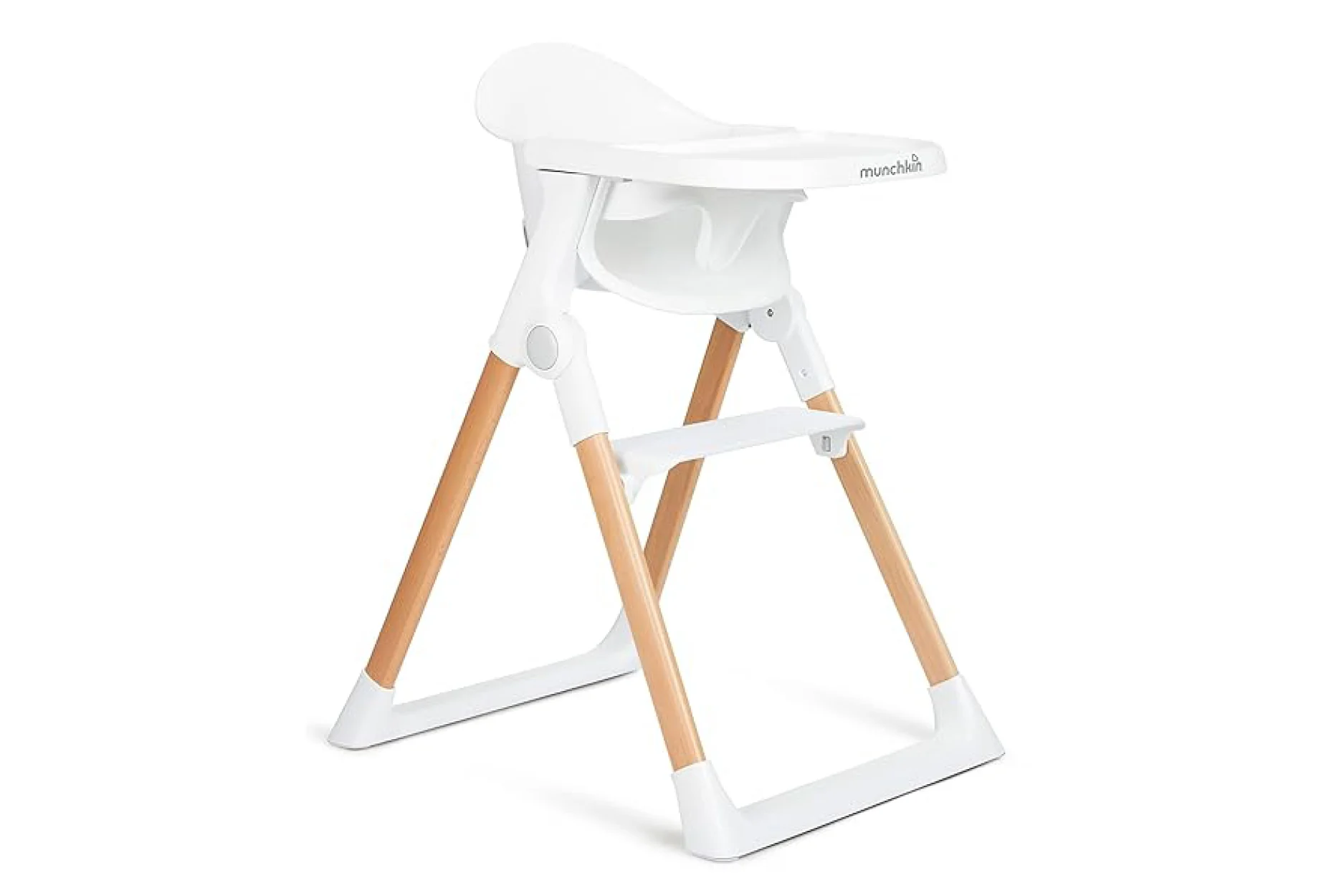
Compact and foldable, this chair weighs 11 lbs and can work well in homes where the chair needs to be stored after each meal. The seat is a bit big, and a small baby may need a blanket roll for extra support. Additionally, the footplate is not fully height adjustable and will likely need a box or other modification for baby to reach.
The weight limit for this chair is 33 lbs, or 3 years, so a toddler alternative will be necessary. The Munchkin Float is easily wipeable, but the tray is not dishwasher safe. The manufacturer does not recommend placing the chair near a table as a child can push hard enough against the table to push the chair over.
Pros
Upright seat with a five-point harness
Removable tray
Folds up for easy storage, lightweight, no assembly required
Cons
Wide footprint (parent tripping hazard)
Not fully adjustable footplate
Seat is big
Summer Deluxe Comfort Folding Booster Seat
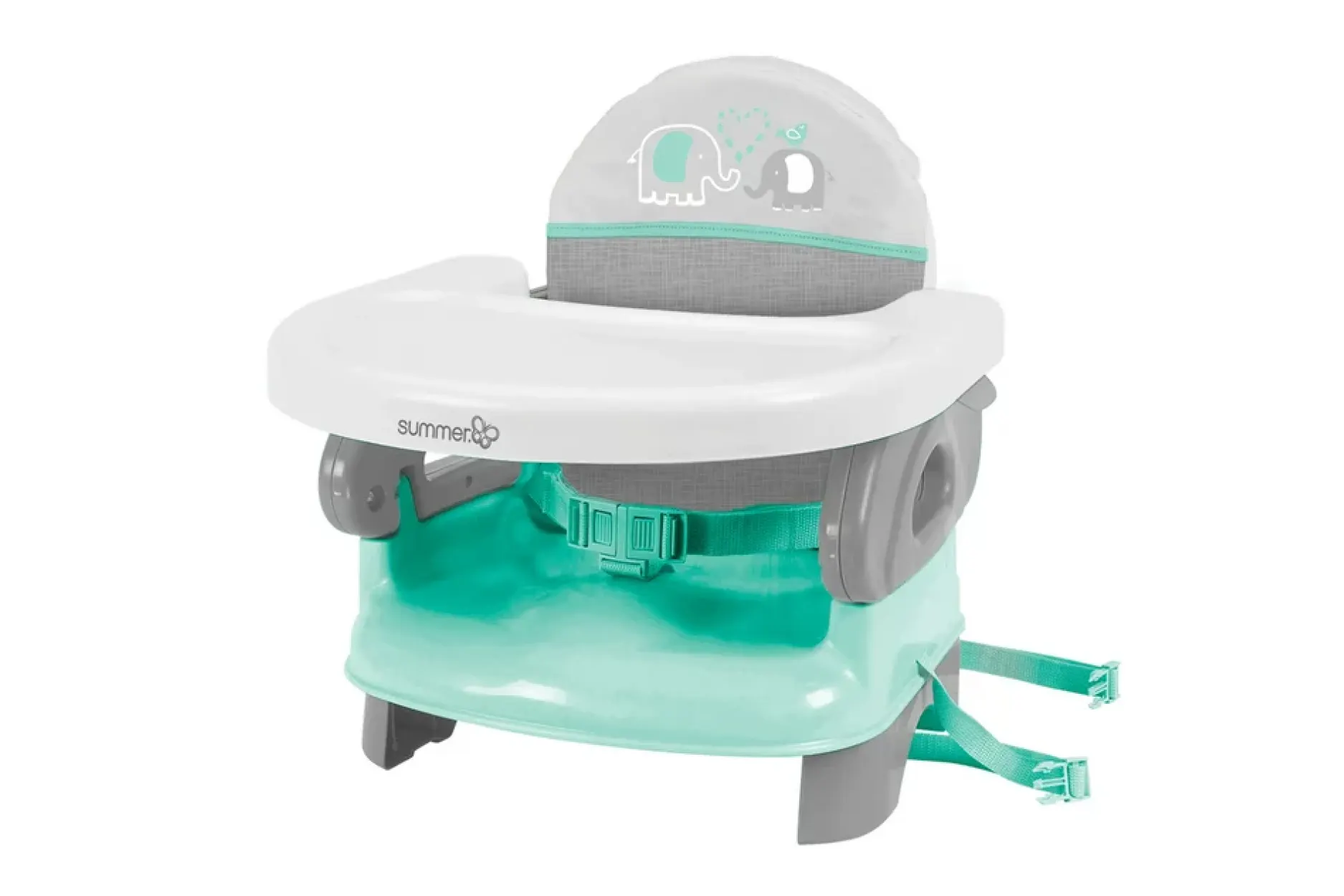
This low-cost high chair is another popular option for families with small spaces. It comes with a three-point safety harness, removable tray, machine washable seat cover, and transitions into a booster seat. The seatback is completely upright. When sitting in the Summer Deluxe seat, a baby’s knees tend to lay straight, supported by the chair seat, and there is no footrest. The max weight for this chair is 33 lbs. This chair also folds up and is easily portable.
Pros
Upright seat
Inexpensive
Small
Portable
Cons
No footrest; requires modifications to get baby to bear weight through the feet
Low seat; difficult for some babies to reach the tray, requiring a towel or blanket to boost height
Upseat Infant Booster Seat
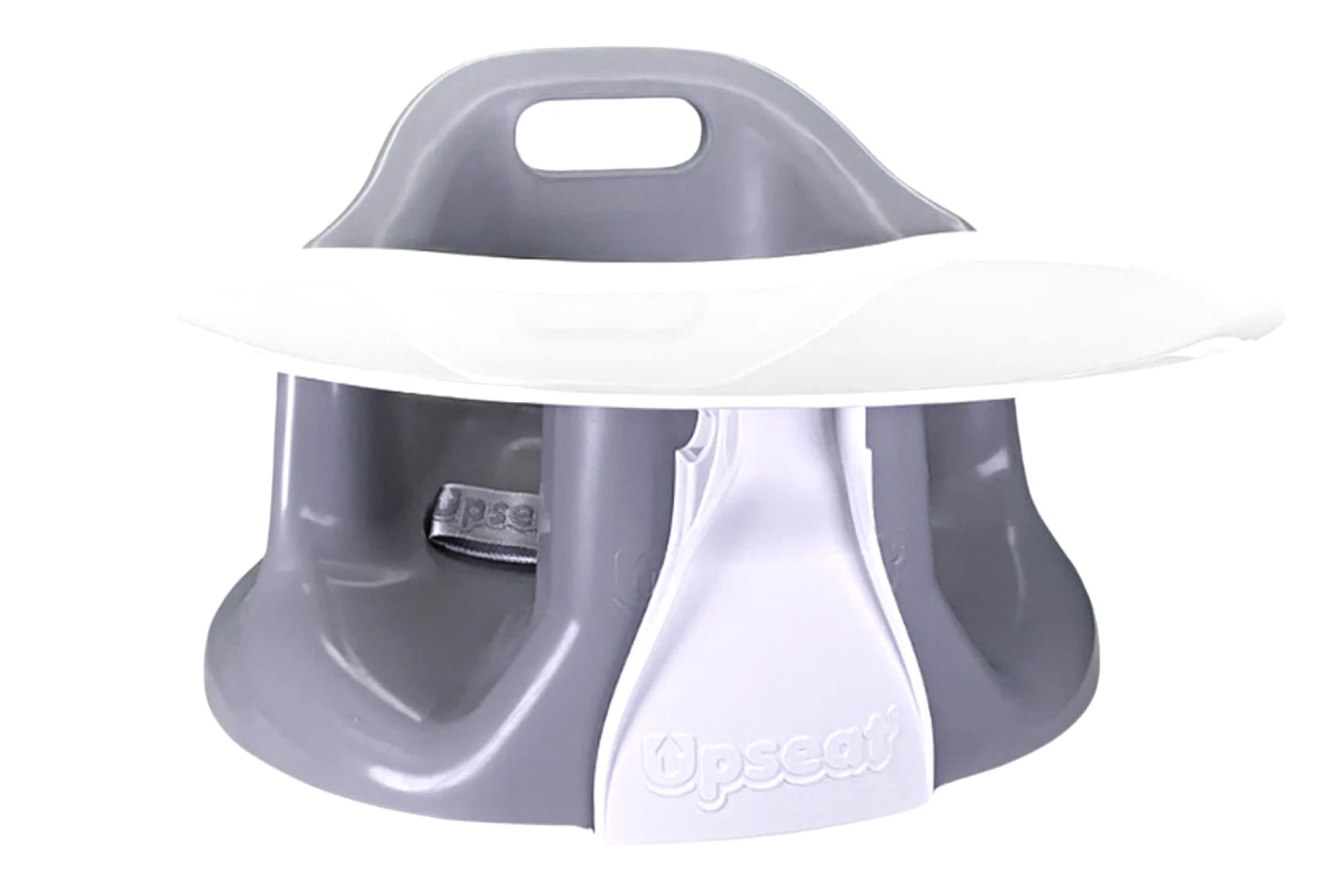
This portable booster seat is also popular and commonly used as an infant positioning device. It comes with a three-point safety harness, a removable tray, and can be strapped to the chair for increased safety. The seatback is completely upright. The seat is designed to rotate the pelvis forward, aligning the shoulders with the hips or slightly forward. There is no footrest. The max weight is 30 lbs.
Pros
Upright seat
Small
Portable
Cons
No footrest, requires modifications for baby to bear weight through the feet
Only three-point harness
Reviews: High Chairs for Small Spaces
These standard high chairs all feature the ability to fold up and easily store in a small apartment or home when not in use. These chairs lack the safety features for fully upright positioning and foot support and are not developmentally appropriate for toddlers.
Baby Jogger City Bistro High Chair

This chair is a favorite for families looking for an easy fold option. This traditional, high seatback chair comes with a five-point harness and washable seat cover, as well as four-level adjustable seat height. The footrest is very small and low, which makes it difficult for an infant or small toddler to reach the footplate. Baby sits in a slightly reclined position with most of the upper leg supported by the seat. The tray is removable. It is easily collapsible and foldable into a small rectangle to store in a small space. Max weight for this chair is 40 lbs.
Pros
Quick, simple fold design
Adjustable seat height
Cons
Seatback does not provide appropriate positioning for total upright posture and bent knees
Footplate not usable without modification
Cloth seat cover is difficult to clean, with a lot of crannies to build up gunk
Cosco Simple Fold Deluxe High Chair & Safety 1st 3-In-1 Grow And Go High Chair
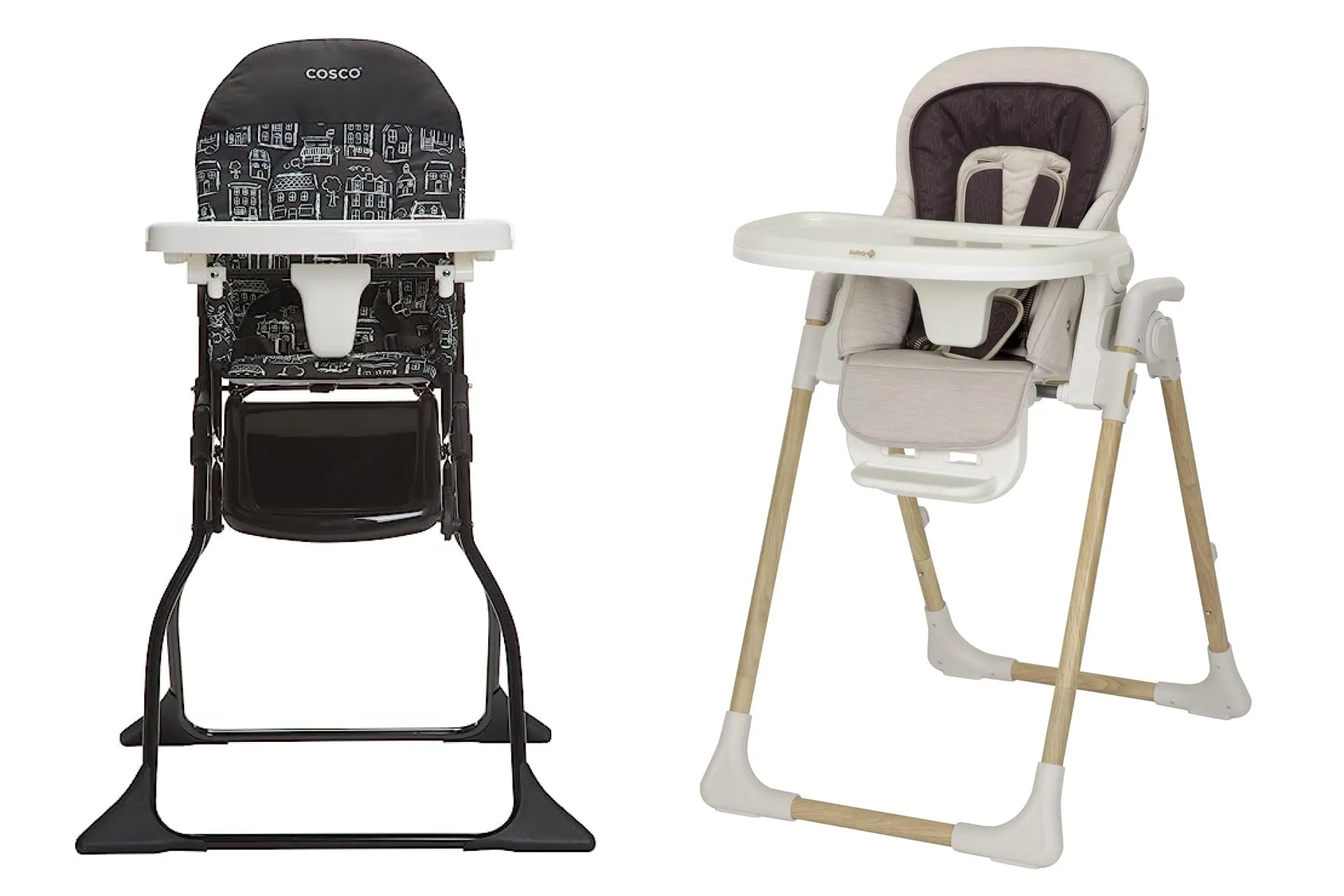
These chairs are similar to the Graco Slim Spaces, and also have easy fold options. Both chairs are traditional, high seatback chairs with washable seat covers. The Cosco Simple Fold has a three-point harness while the Grow and Go chair has a five-point harness. The footrests are very small and low, making it difficult for an infant or small toddler to reach. When sitting in these seats, baby sits in a slightly reclined position with most of the upper leg supported by the seat. The large tray is removable. Both chairs are easily collapsible and foldable to store in a small space. Max weight for both chairs is 50 lbs.
Pros
Quick, simple fold design
Very affordable
Cons
Seatback does not provide appropriate positioning for total upright posture and it is difficult for the knees to bend at 90 degrees.
Footplate not usable without modification
Not as sturdy; a bigger, stronger infant or toddler can easy to rock
Graco Slim Snacker Highchair & Evenflo Symmetry Fold-Flat High Chair
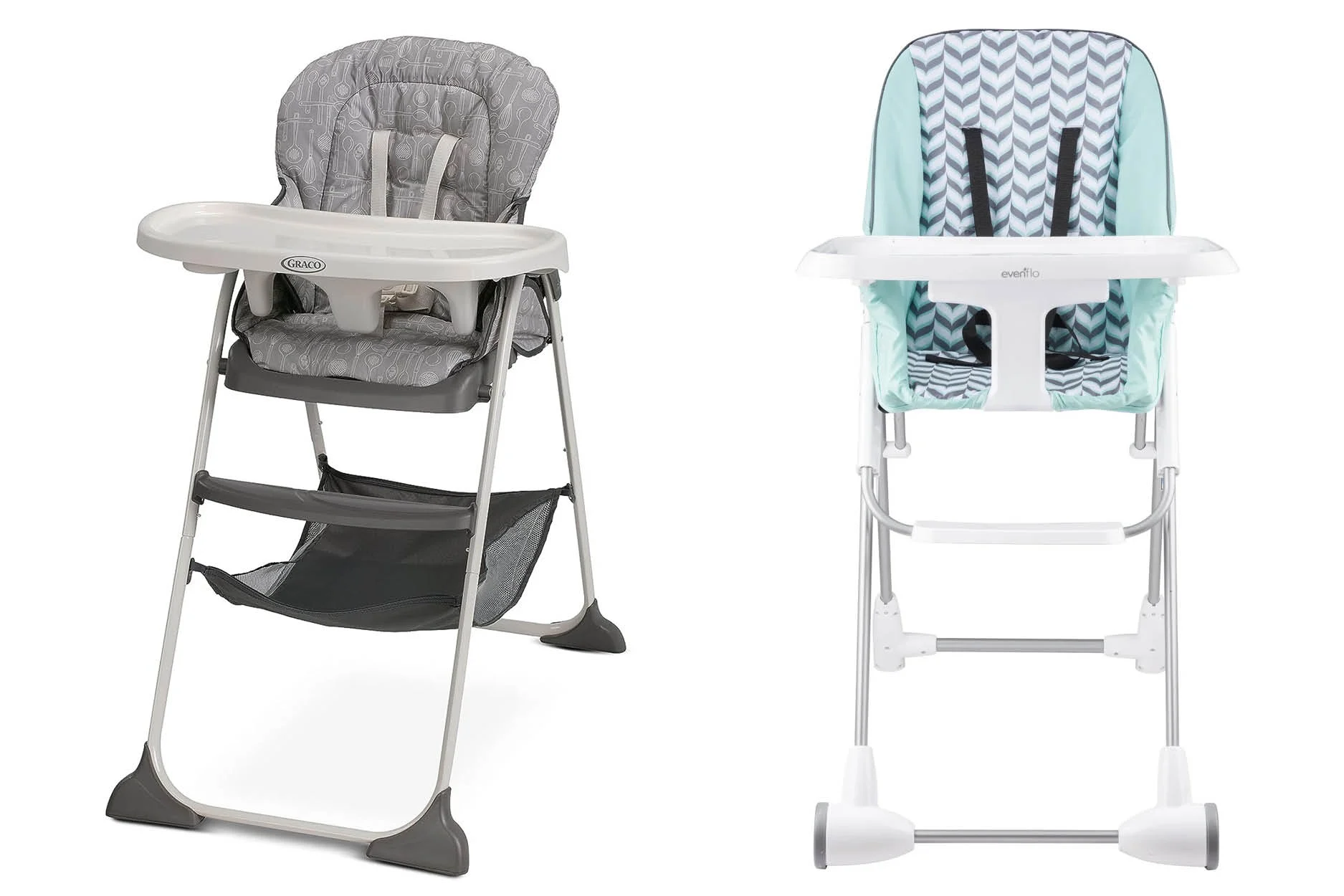
These chairs are similar to the Baby Jogger Bistro, and also have an easy fold option. These traditional, high seatback chairs come with three- and five-point harness options and washable seat covers. These chairs feature very small, low footrests, which are difficult for an infant or small toddler to reach. The Evenflow is on wheels, which need to be carefully locked for safety.
These chairs are reclinable. With the Graco chair, the large tray is removable, but a small snack tray remains, so you can’t pull this chair fully up to the table. The Evenflow tray is fully removable.
These chairs are easily collapsible and foldable to store in a small space. Max weight for these chairs is 40 lbs.
Pros
Quick, simple fold design
Easy to move around the home
Cons
Seatback does not provide appropriate positioning for total upright posture, and despite leg rests, it is difficult for the knees to truly bend at 90 degrees
Footplate not usable without modification
Graco is not able to pull up to the table to join the family meal
Can be unstable with the wheels
Joovy Nook NB High Chair Compact Fold Reclinable Seat

This chair is a more traditional design with a high, padded reclining seatback. It comes with a five-point harness. There is a small footrest, which is not adjustable and not high enough for most babies and young toddlers to reach. The tray easily swings open but is slightly more difficult to remove fully. The chair has front wheels for easy moving, but this does decrease the overall stability of the chair. The chair folds up into a thin rectangle shape, weighing 15 lbs. The max weight for this chair is 50 lbs.
Pros
Easy to store when not in use
Five-point harness for safety
Wipeable seat cover
Cons
Reclining seatback; although it adjusts to upright, it does not support proper alignment of baby’s pelvis and shoulders
Footrest is too low and small, requires modification for baby to reach
Easy to rock and can be unsteady for older infants and toddlers
Ready to get started?
Download the app to start your journey.
Expert Tips Delivered to Your Inbox
Sign up for weekly tips, recipes and more!
Copyright © 2025 • Solid Starts Inc
